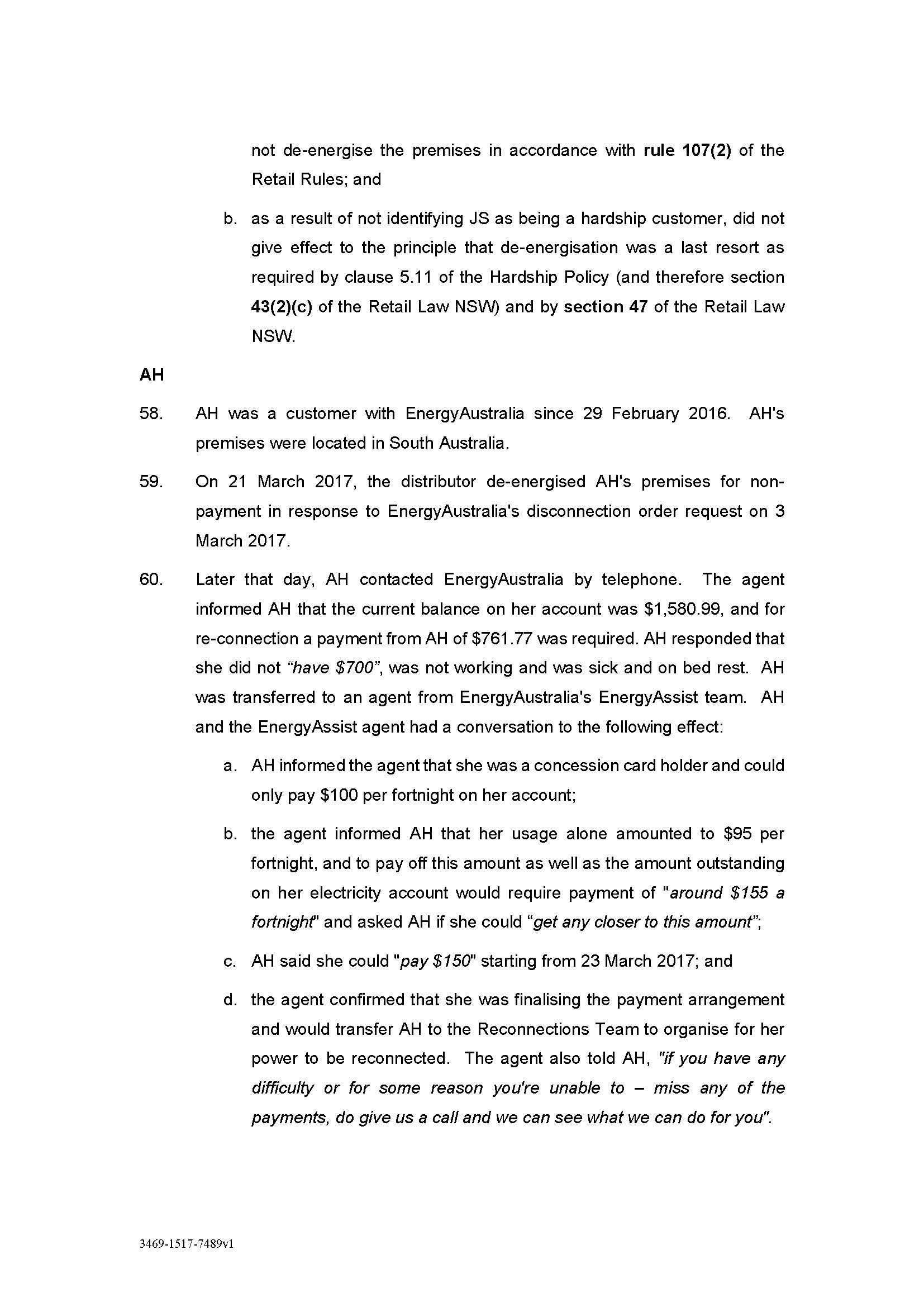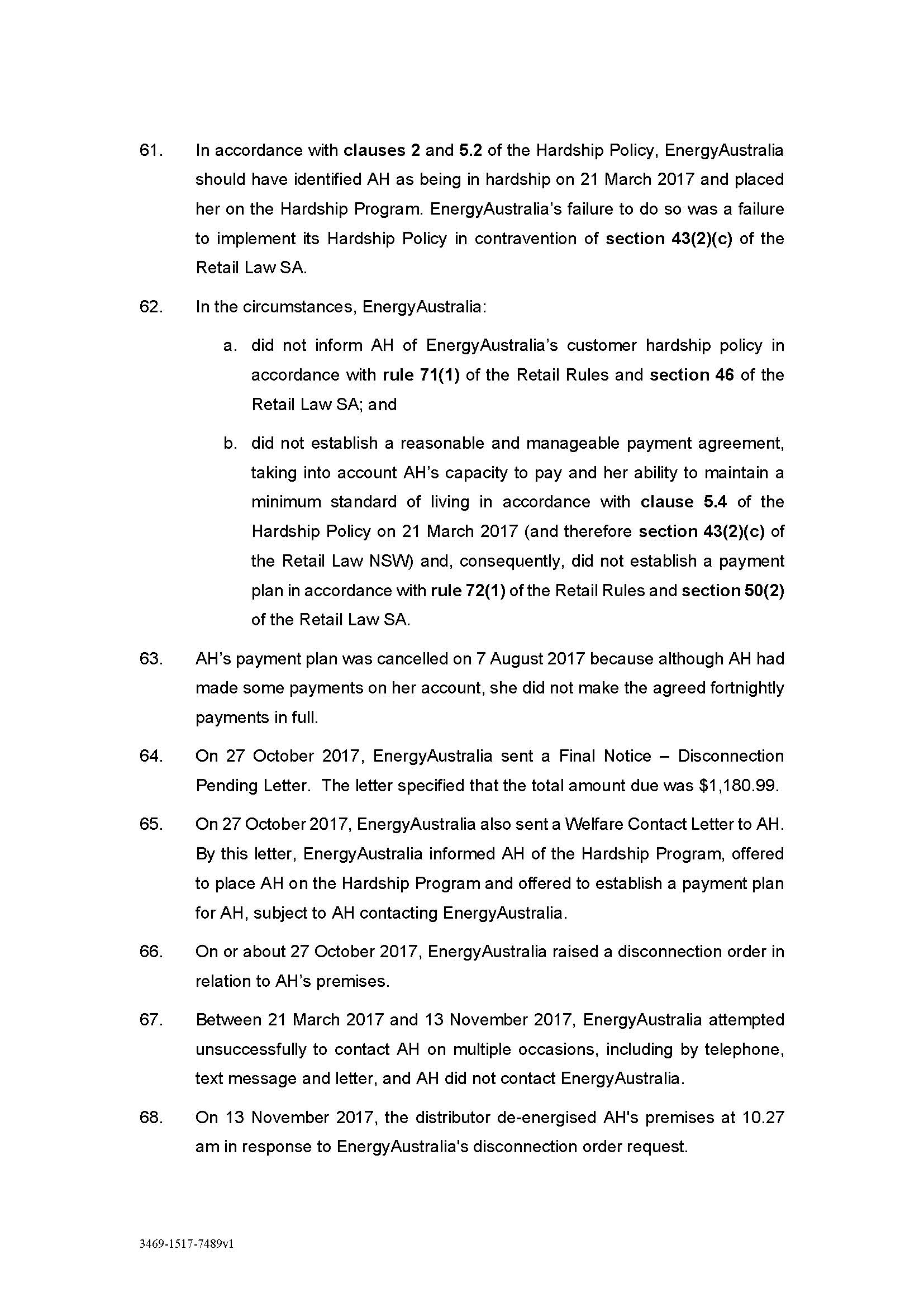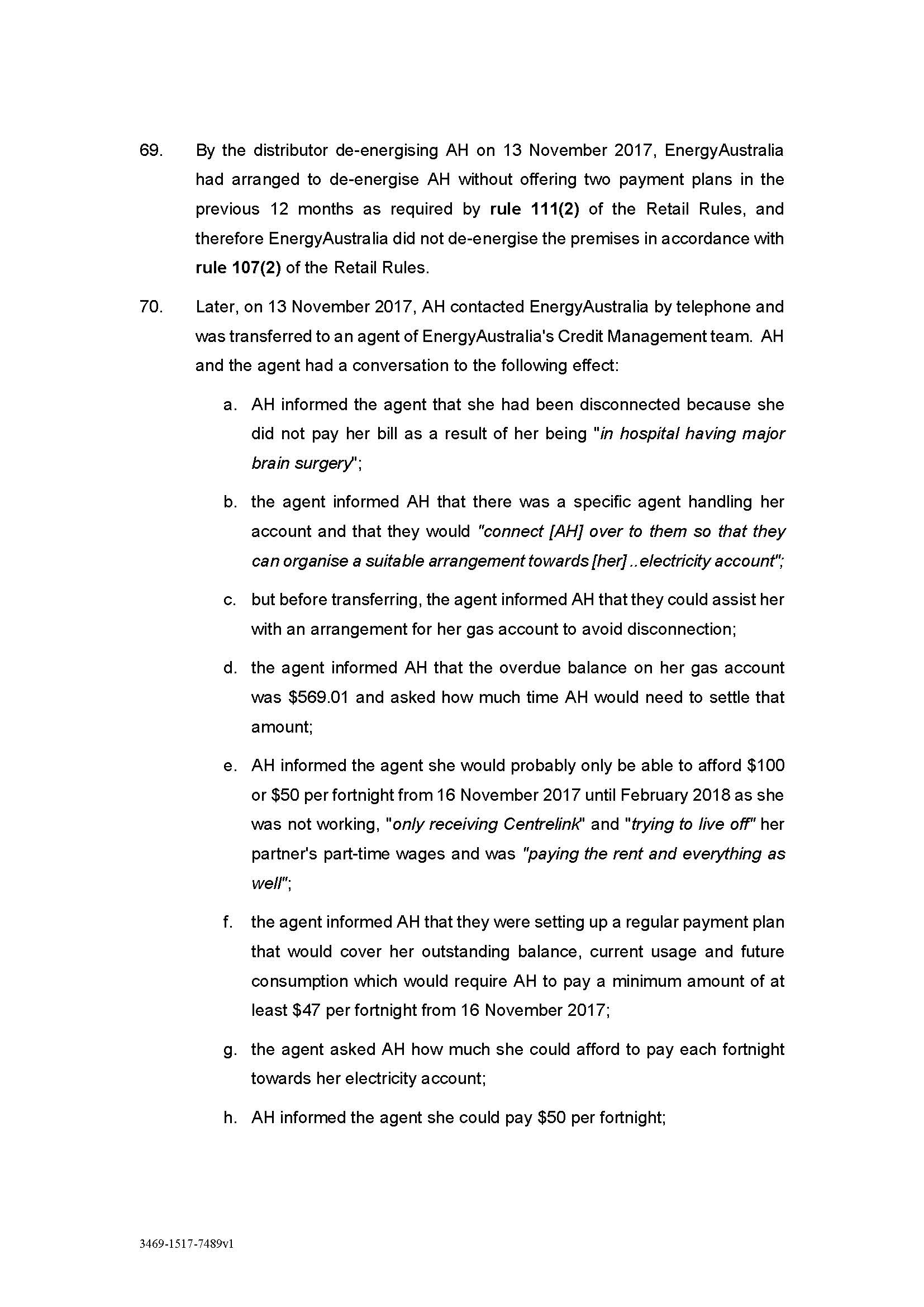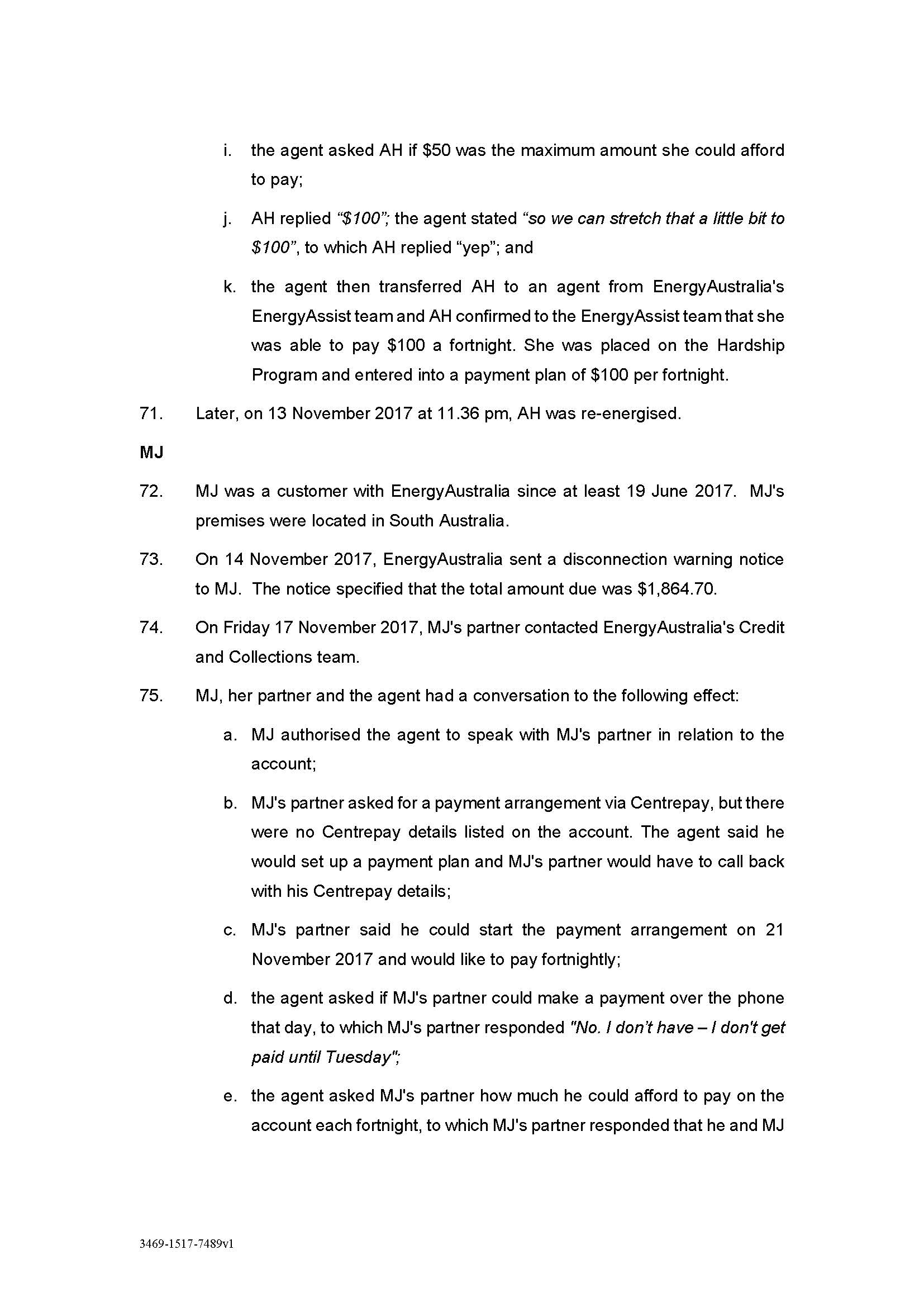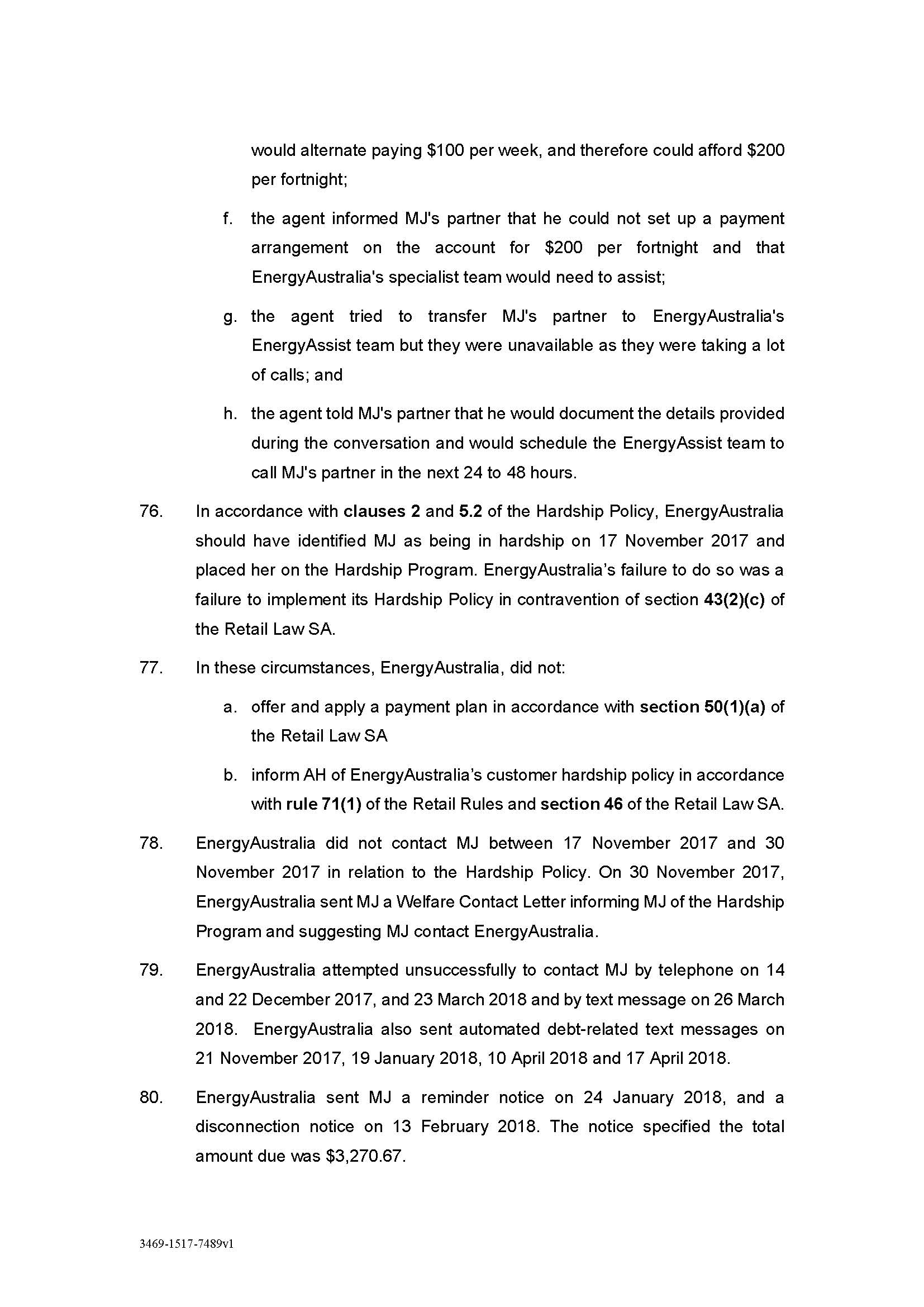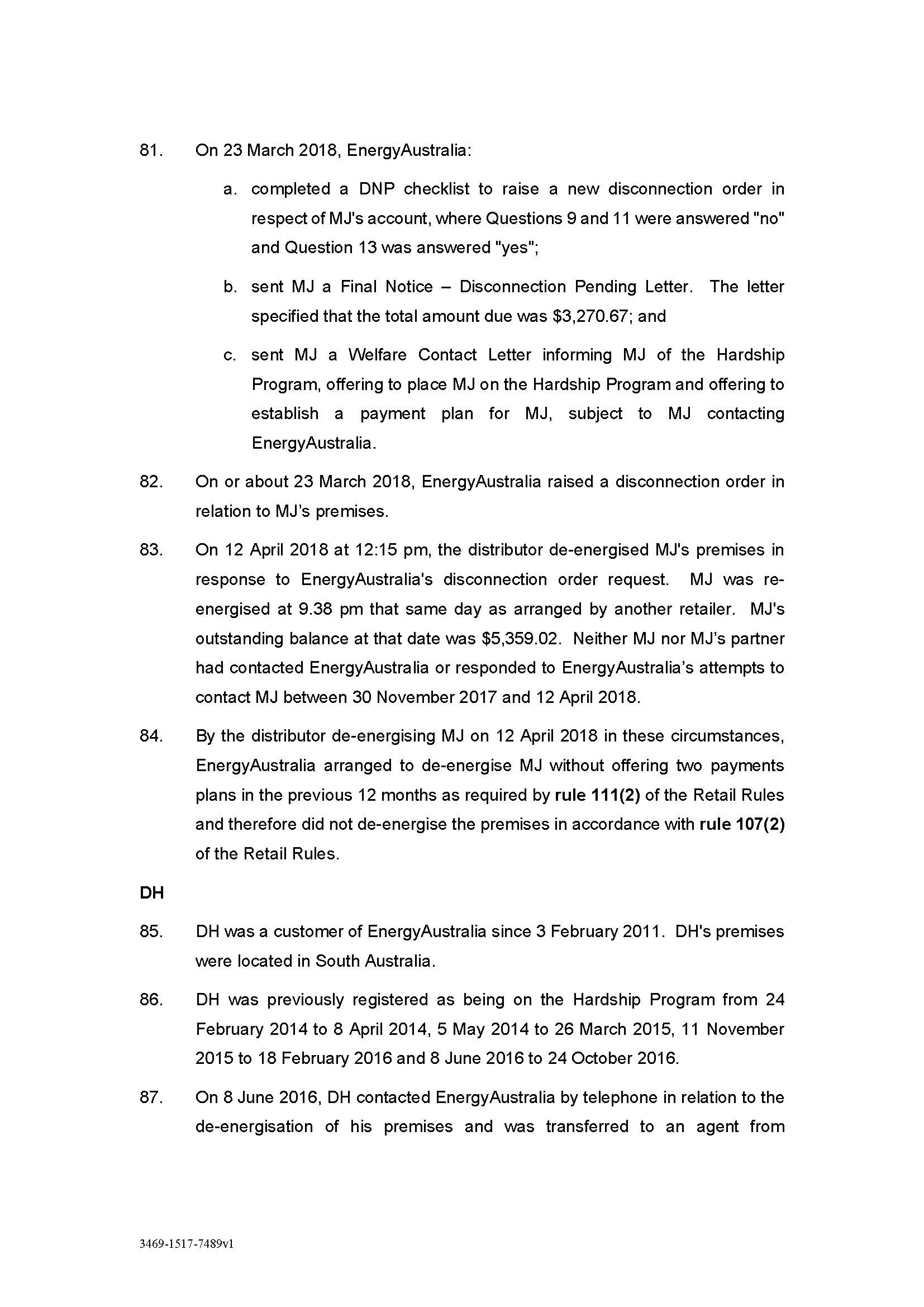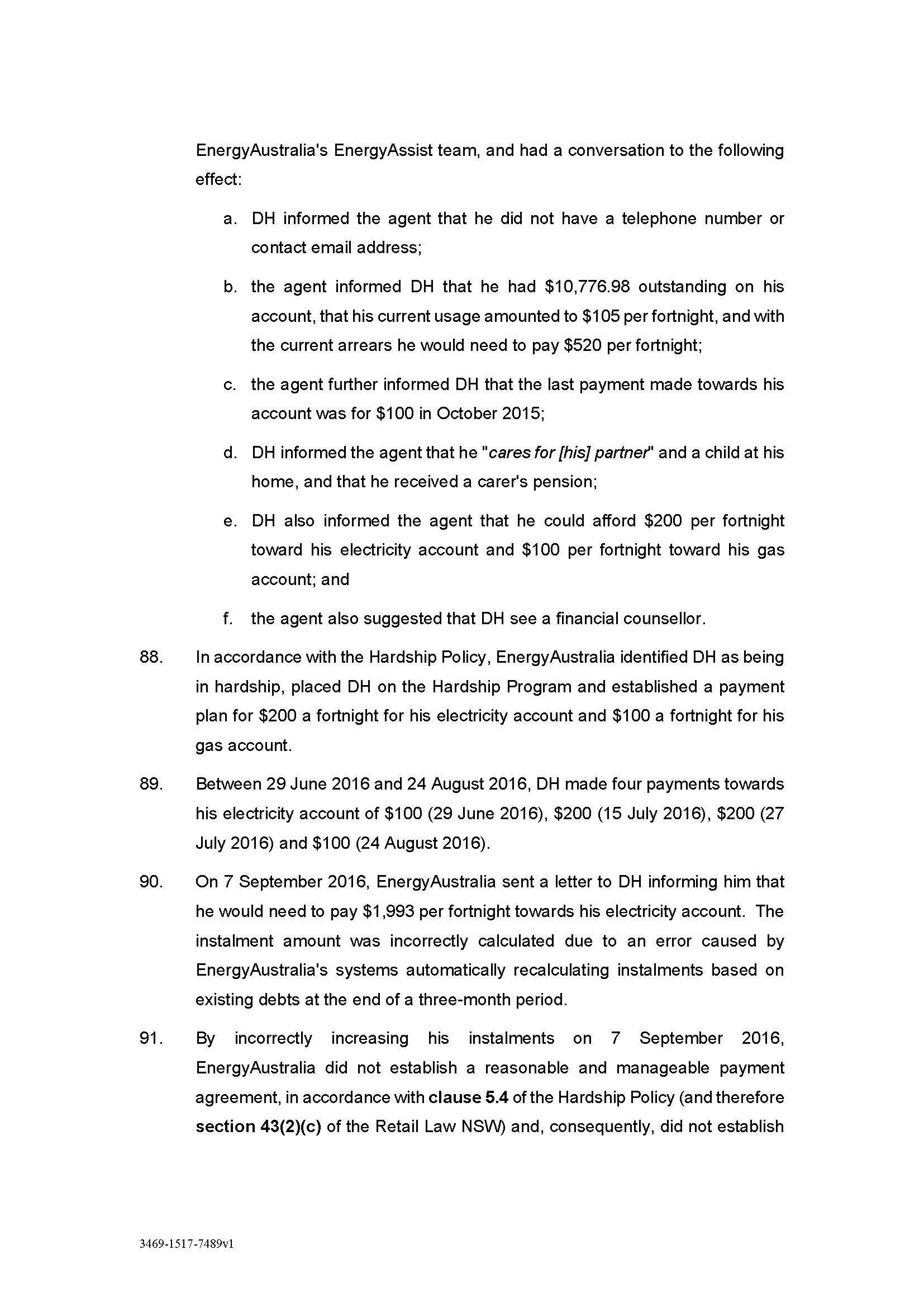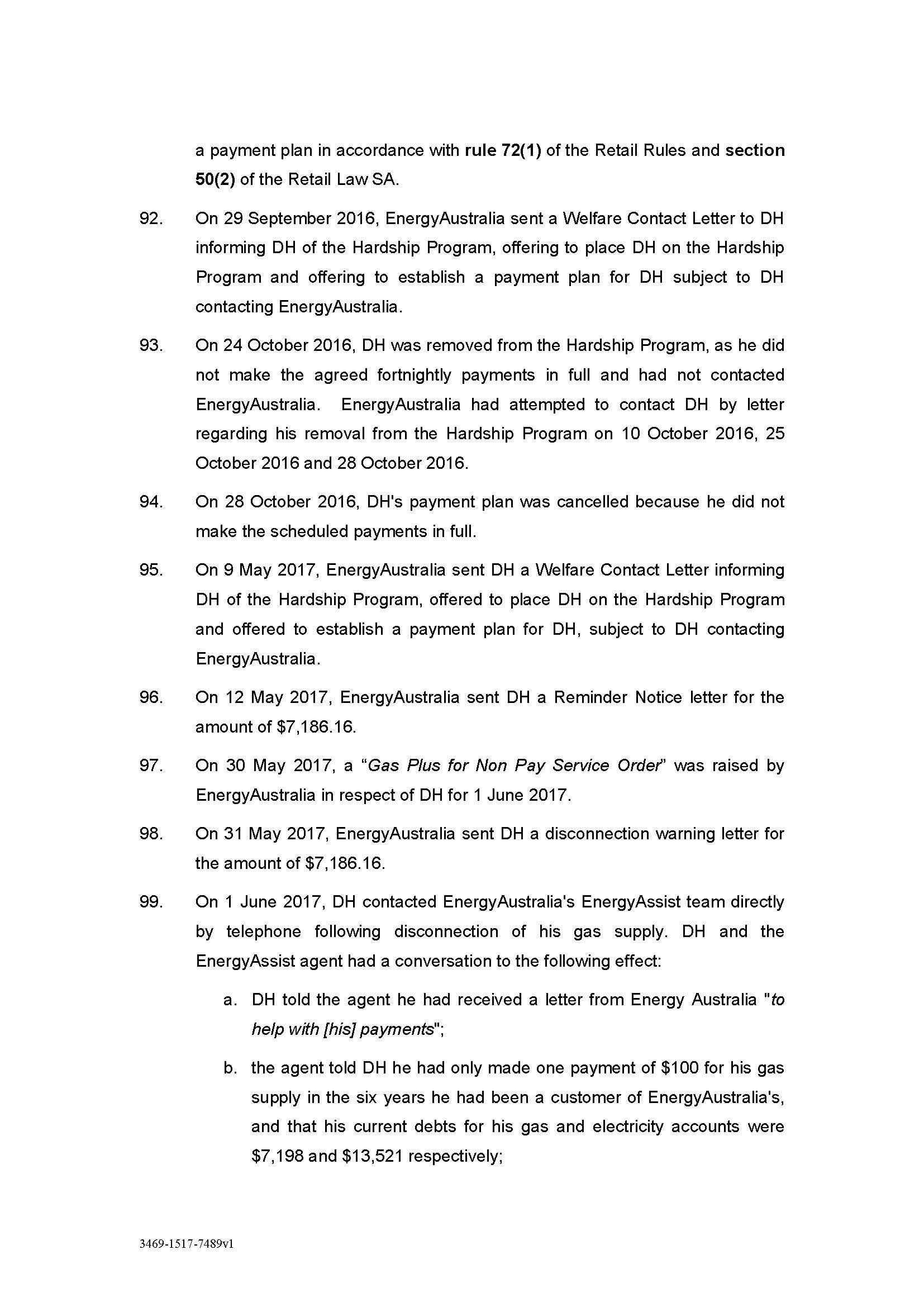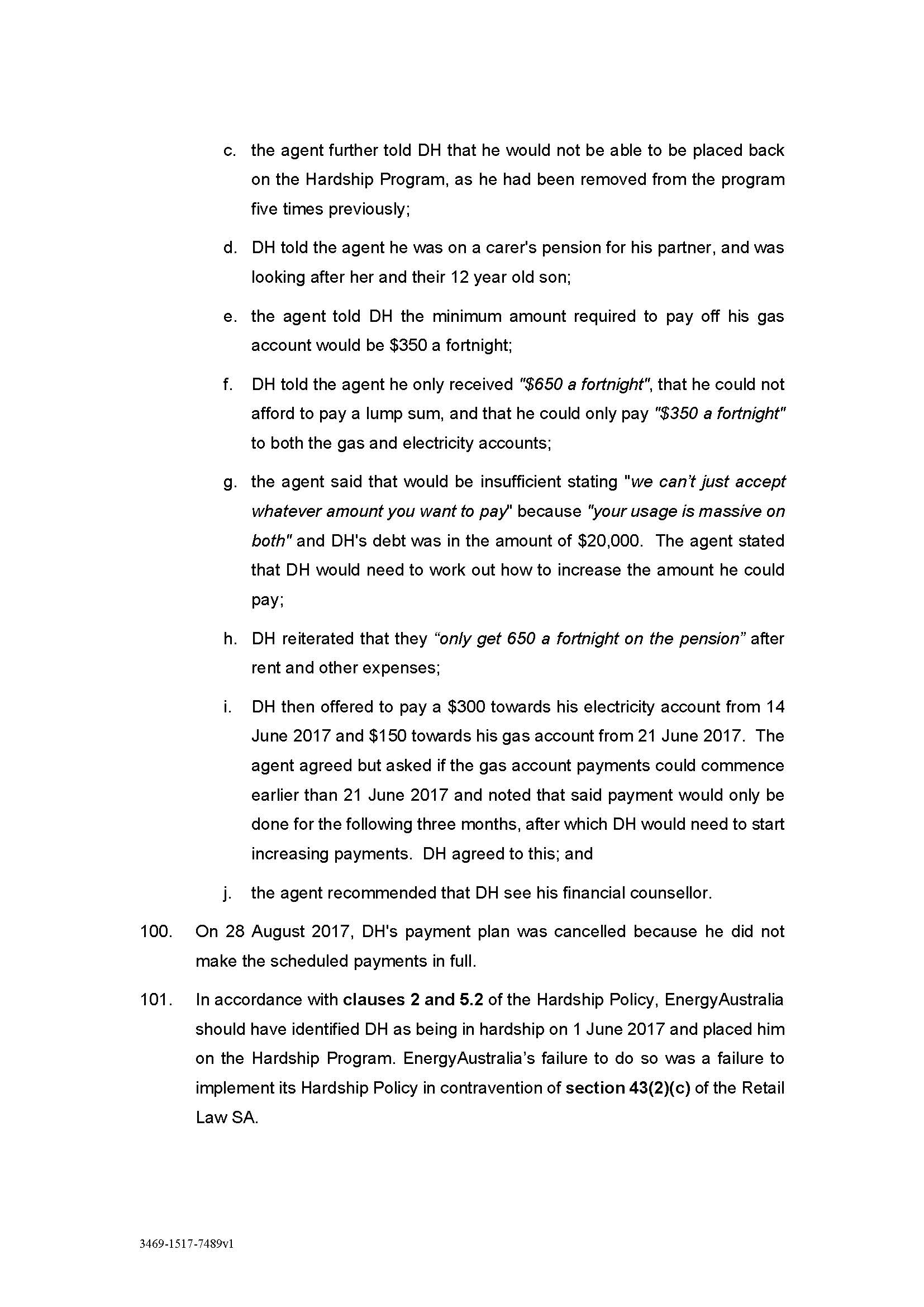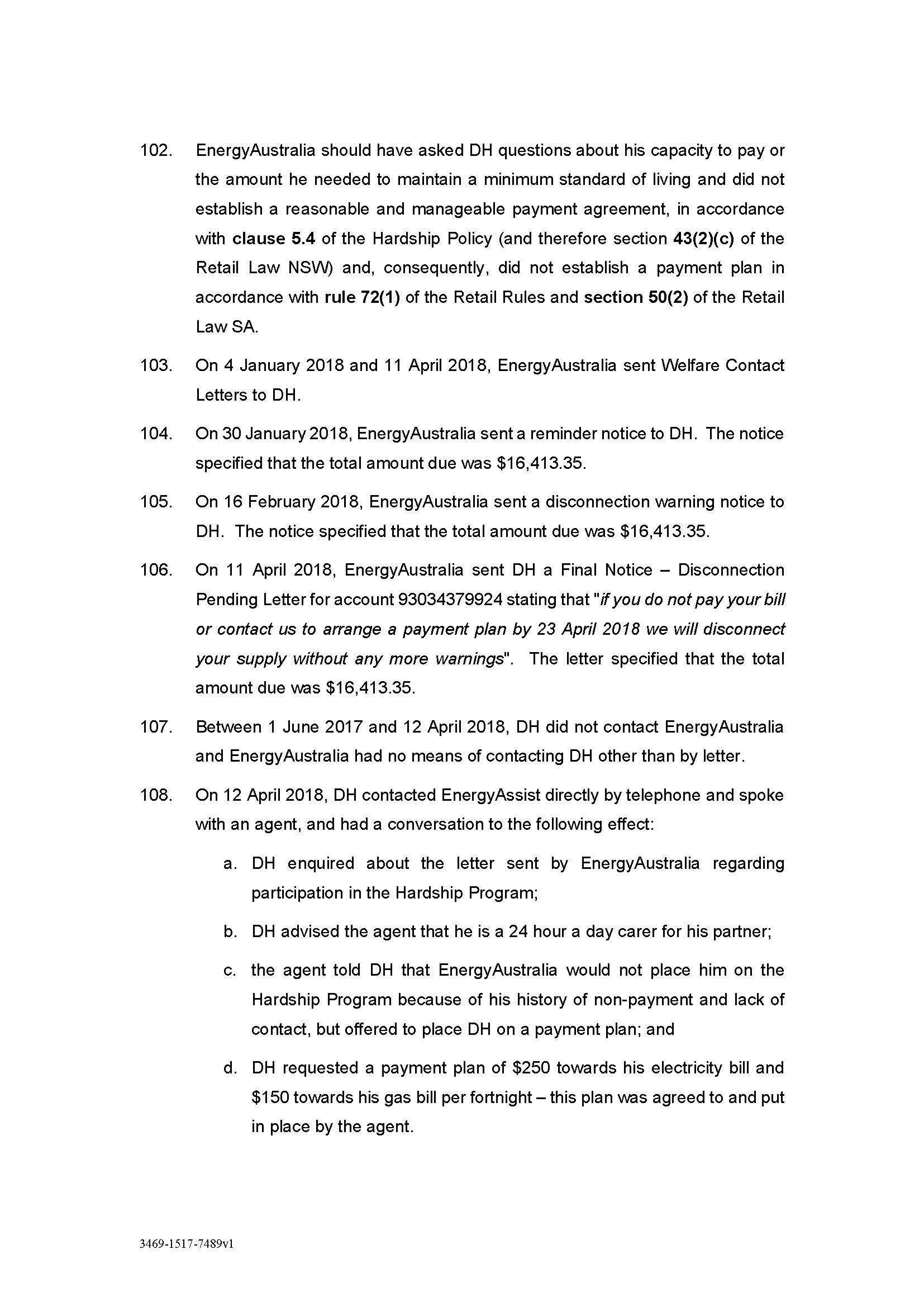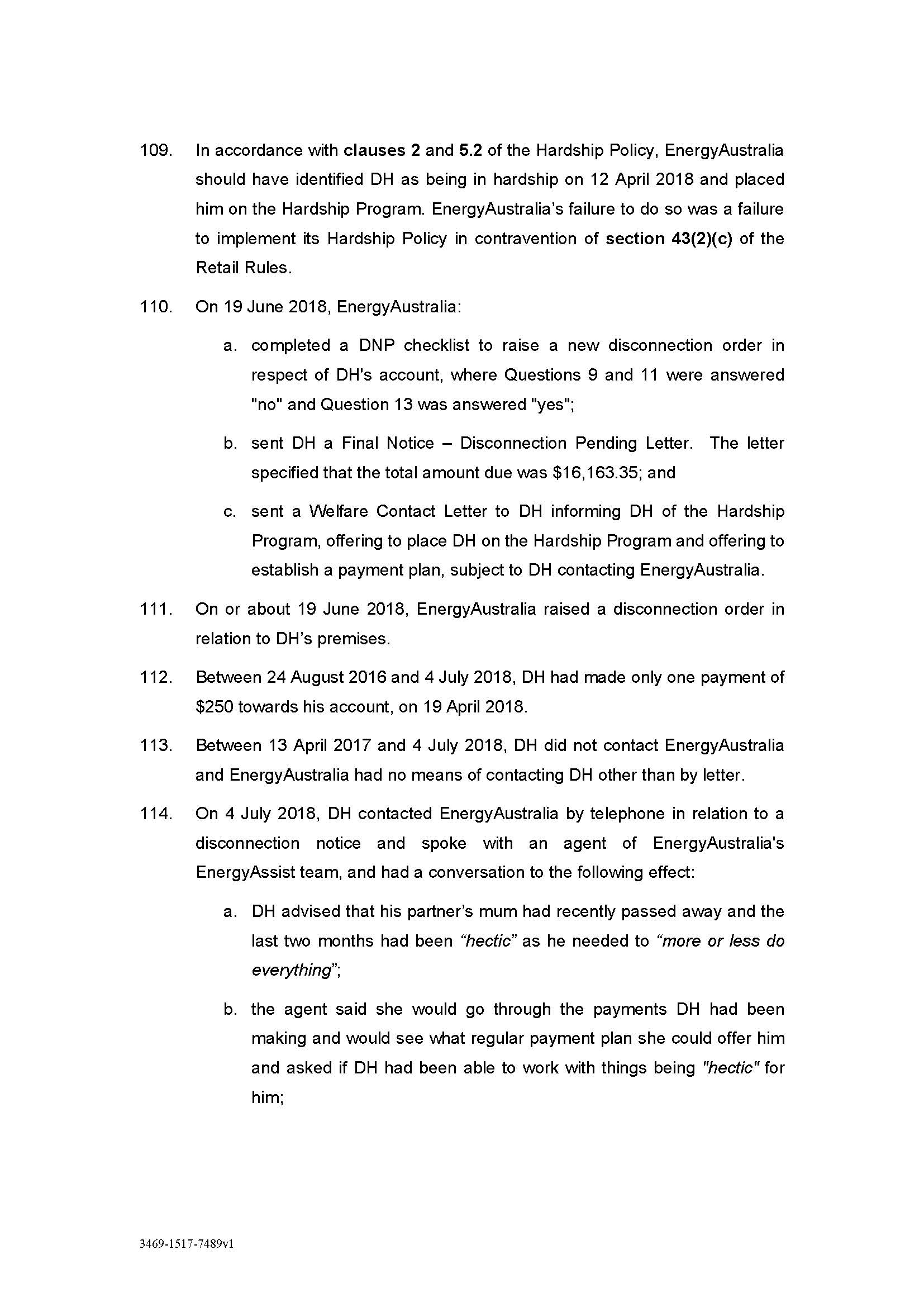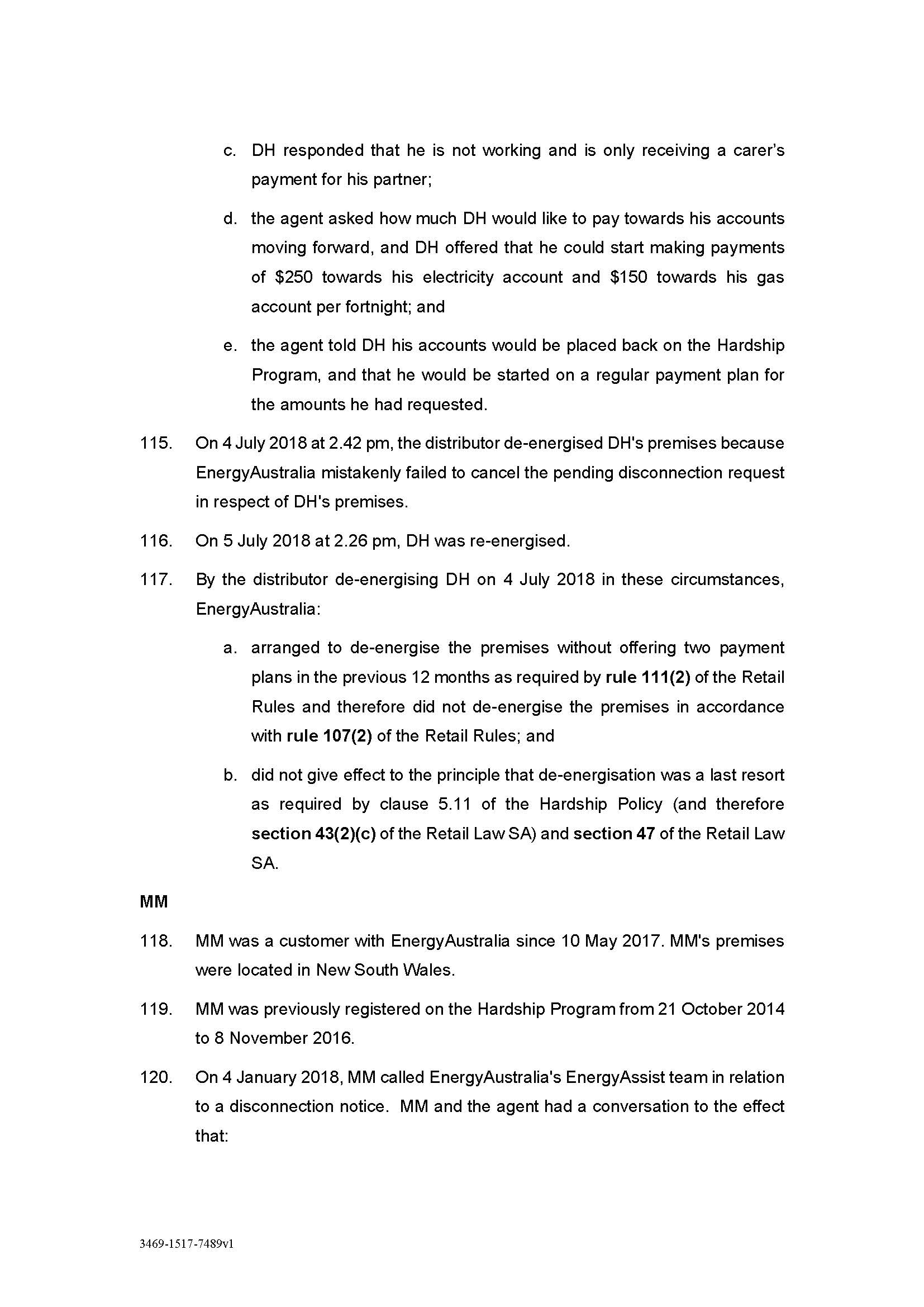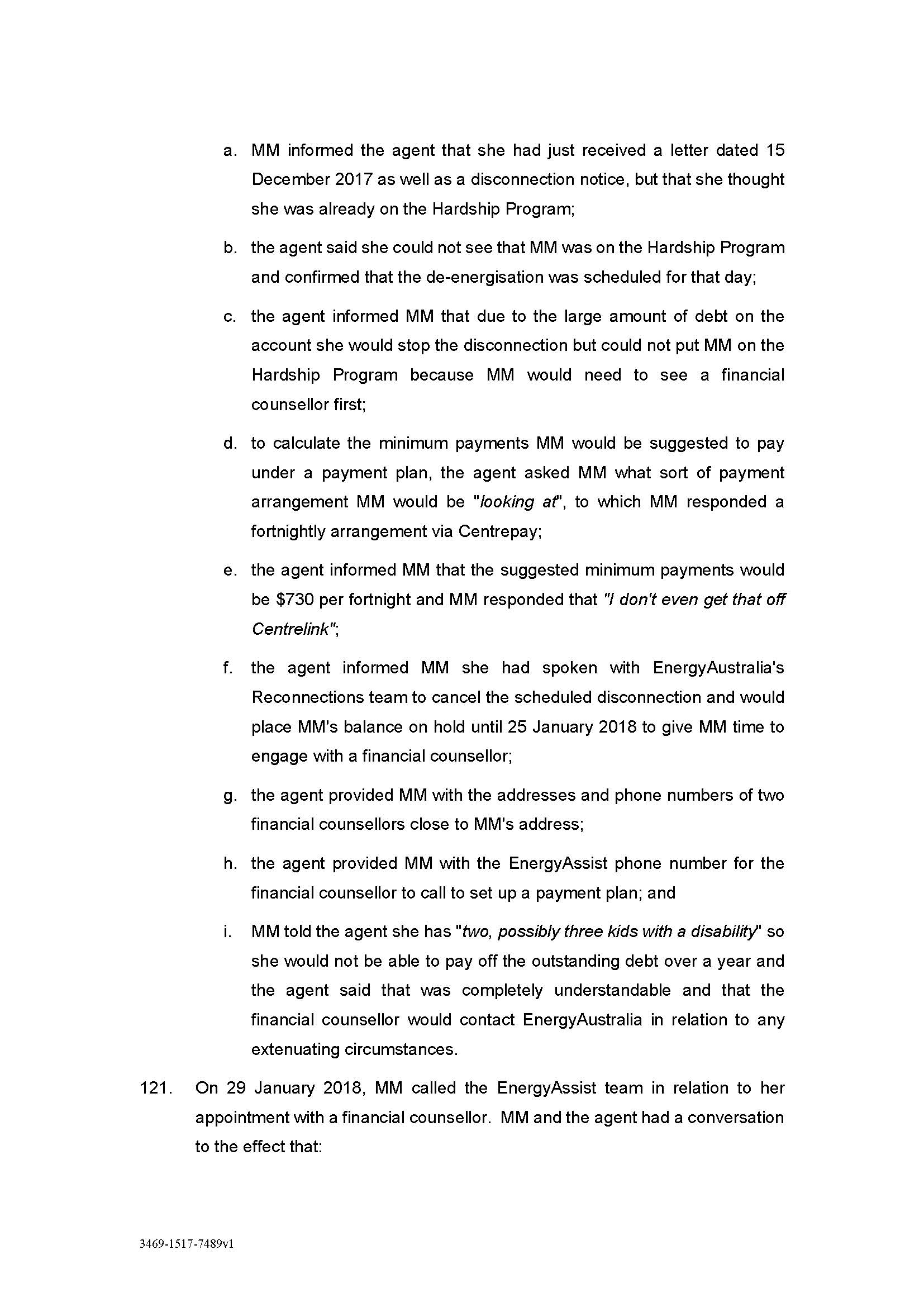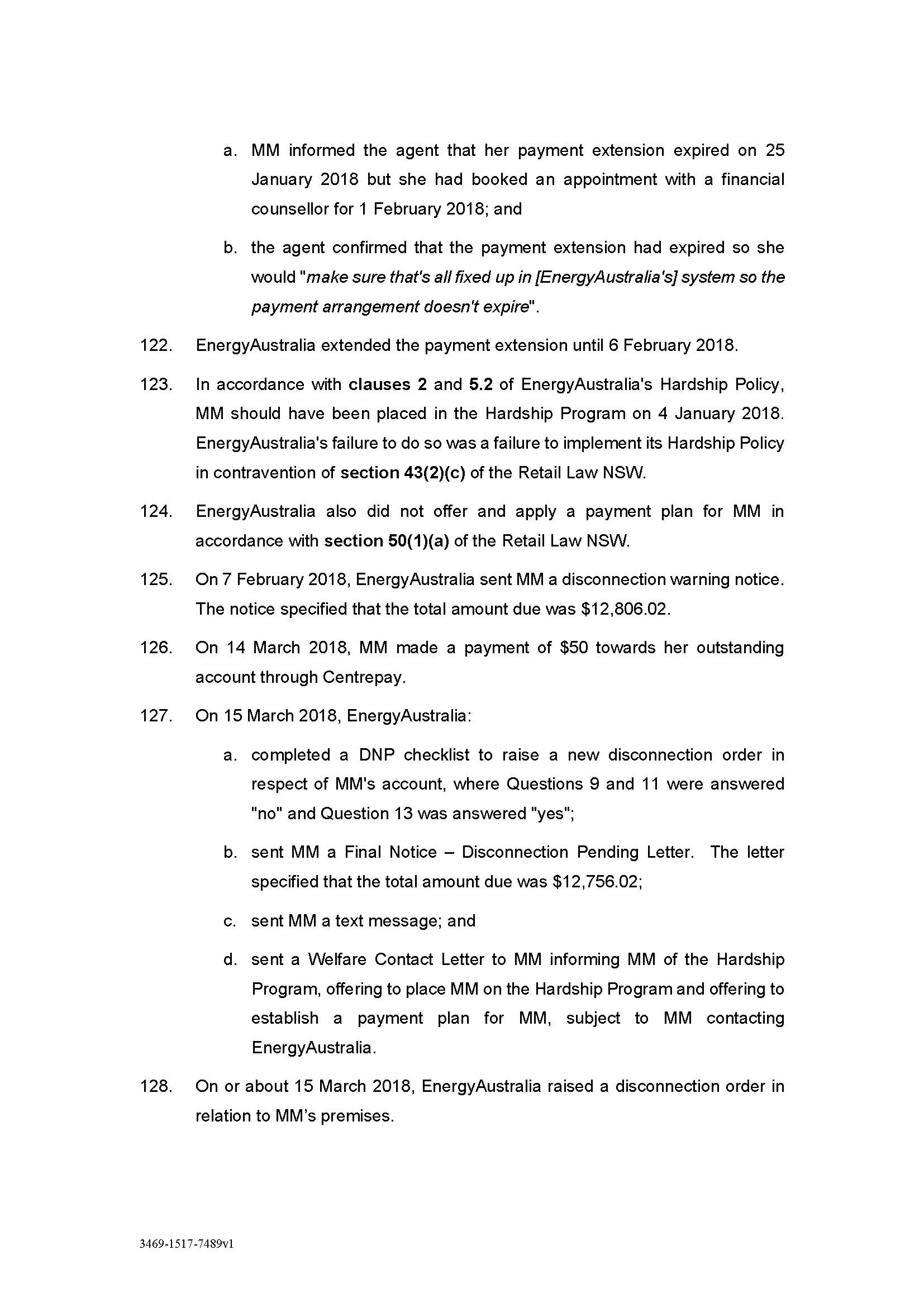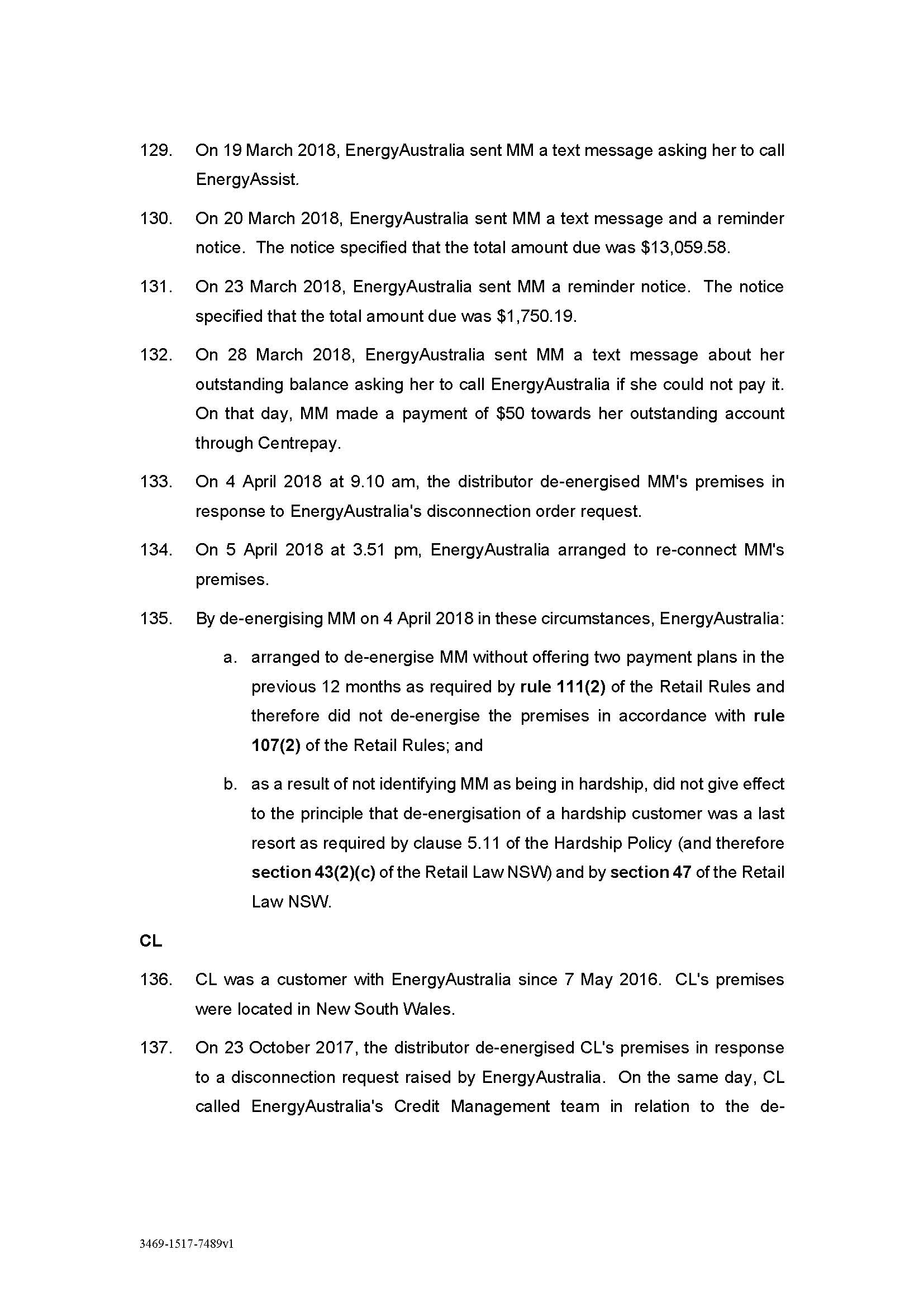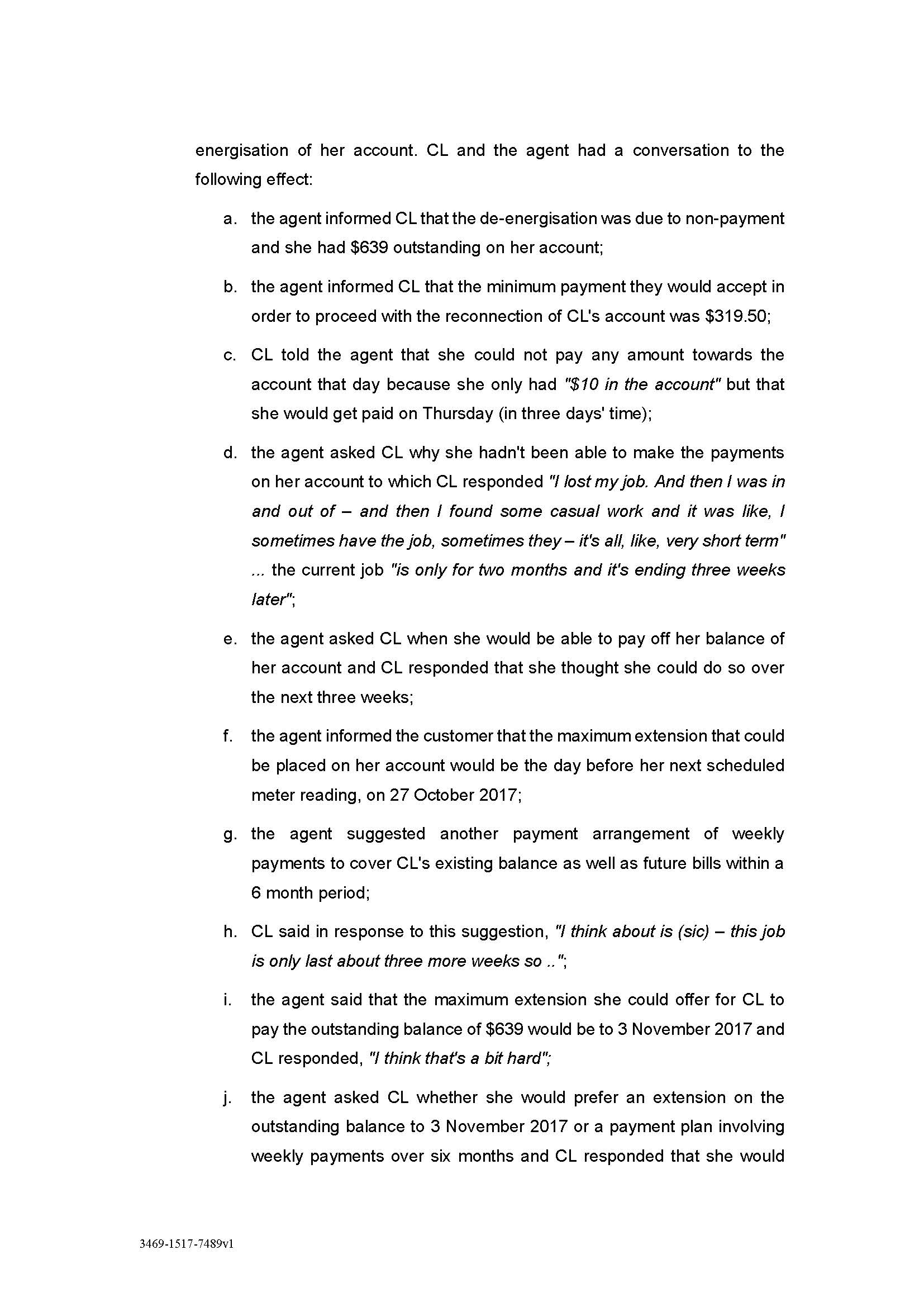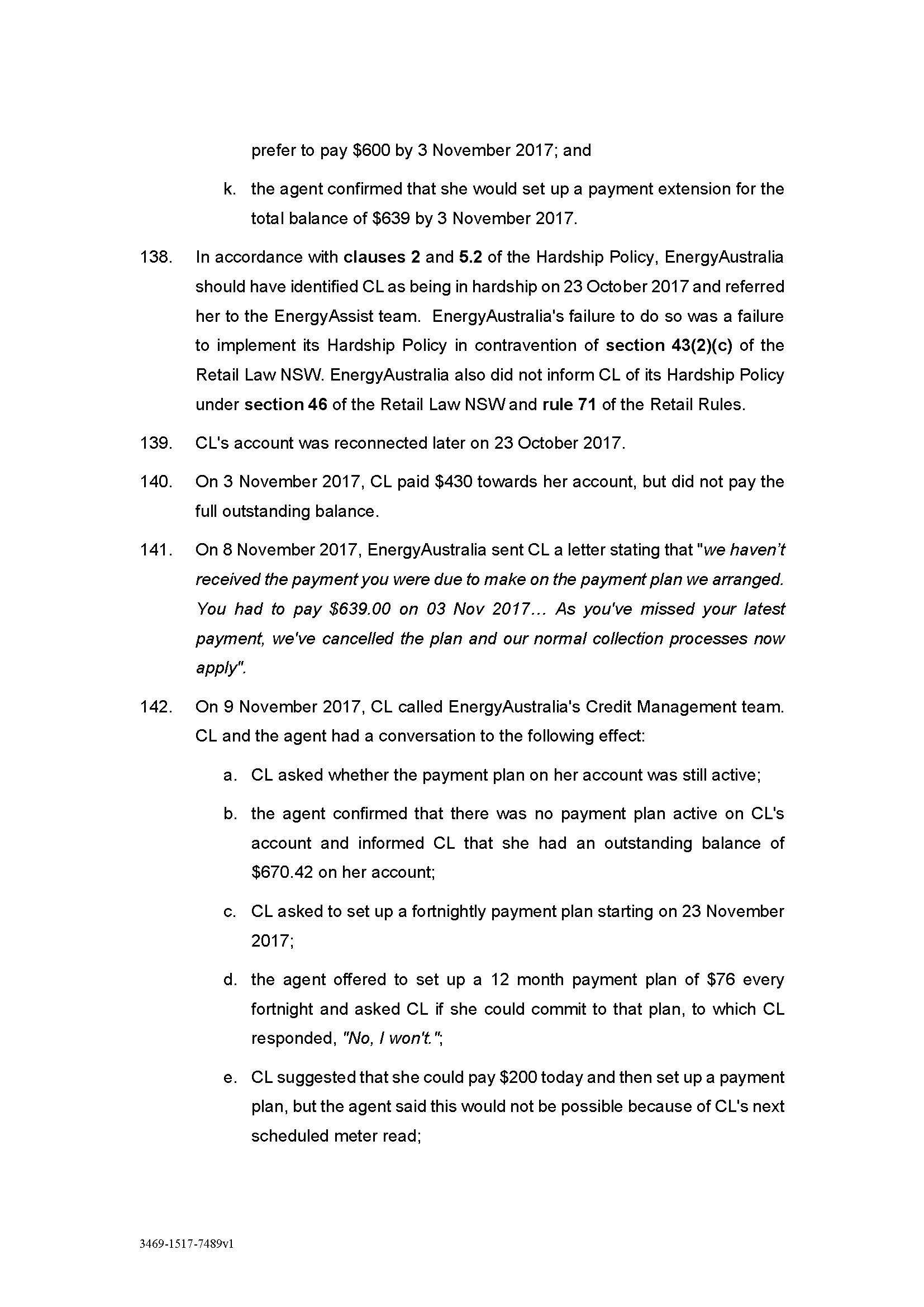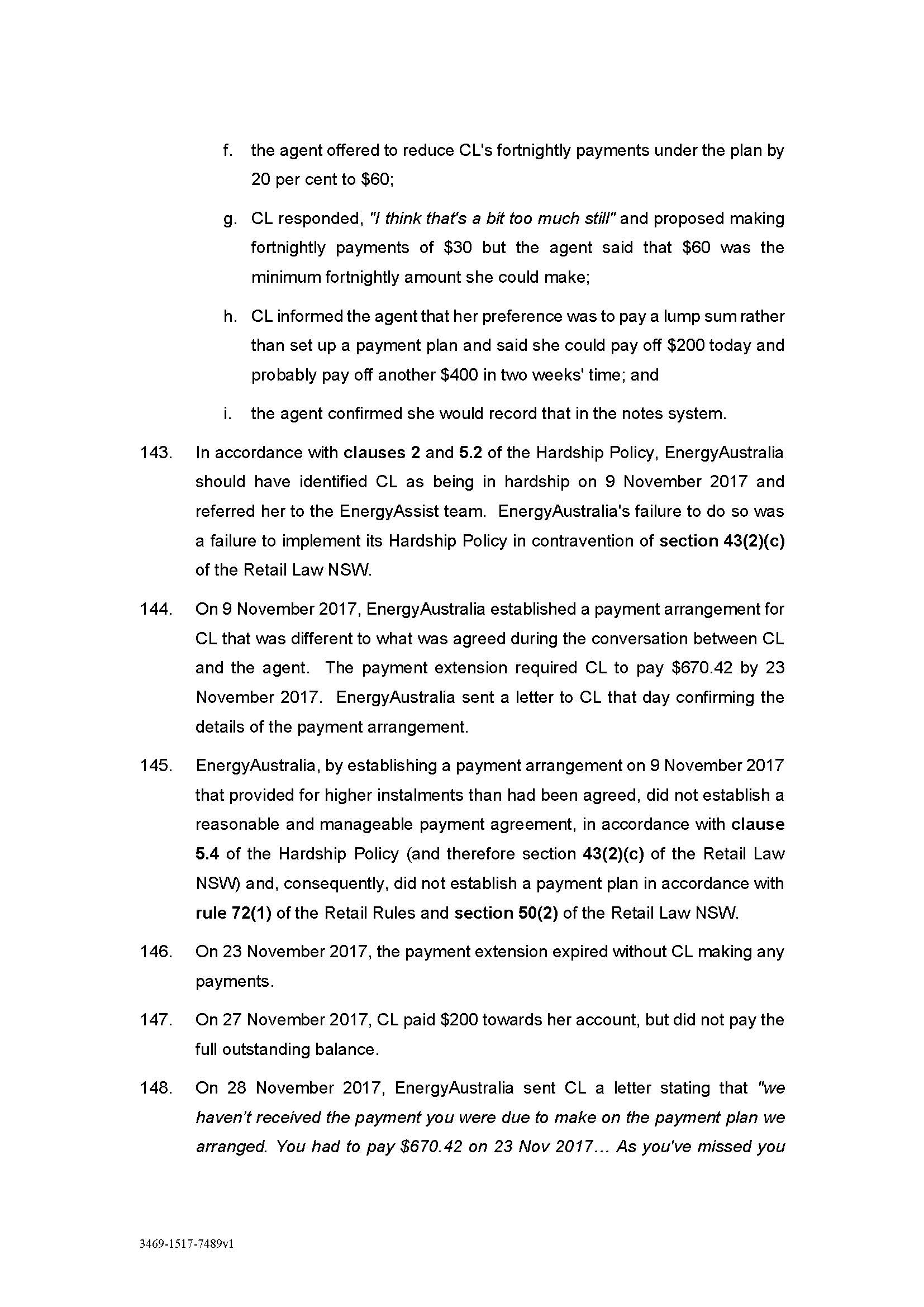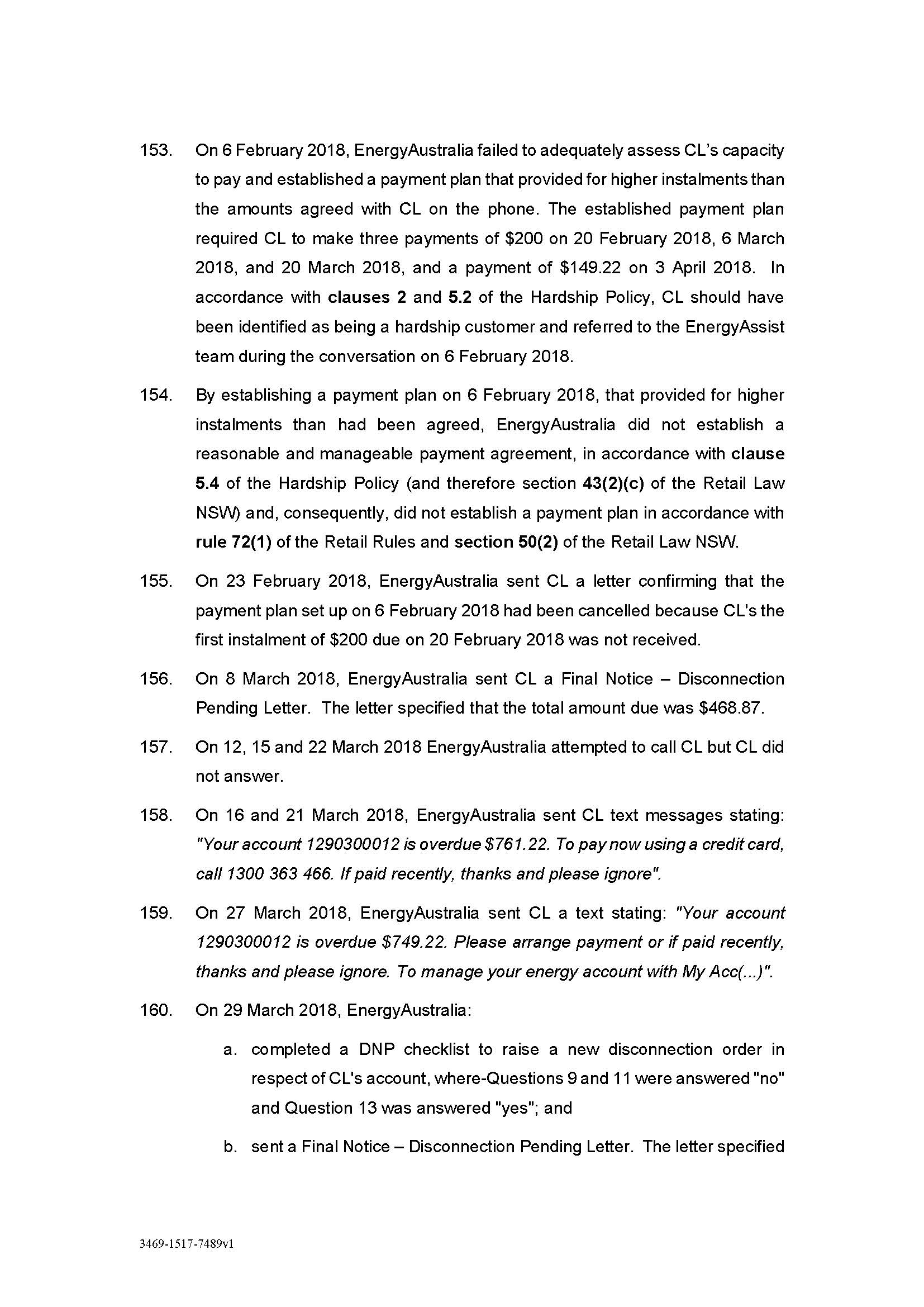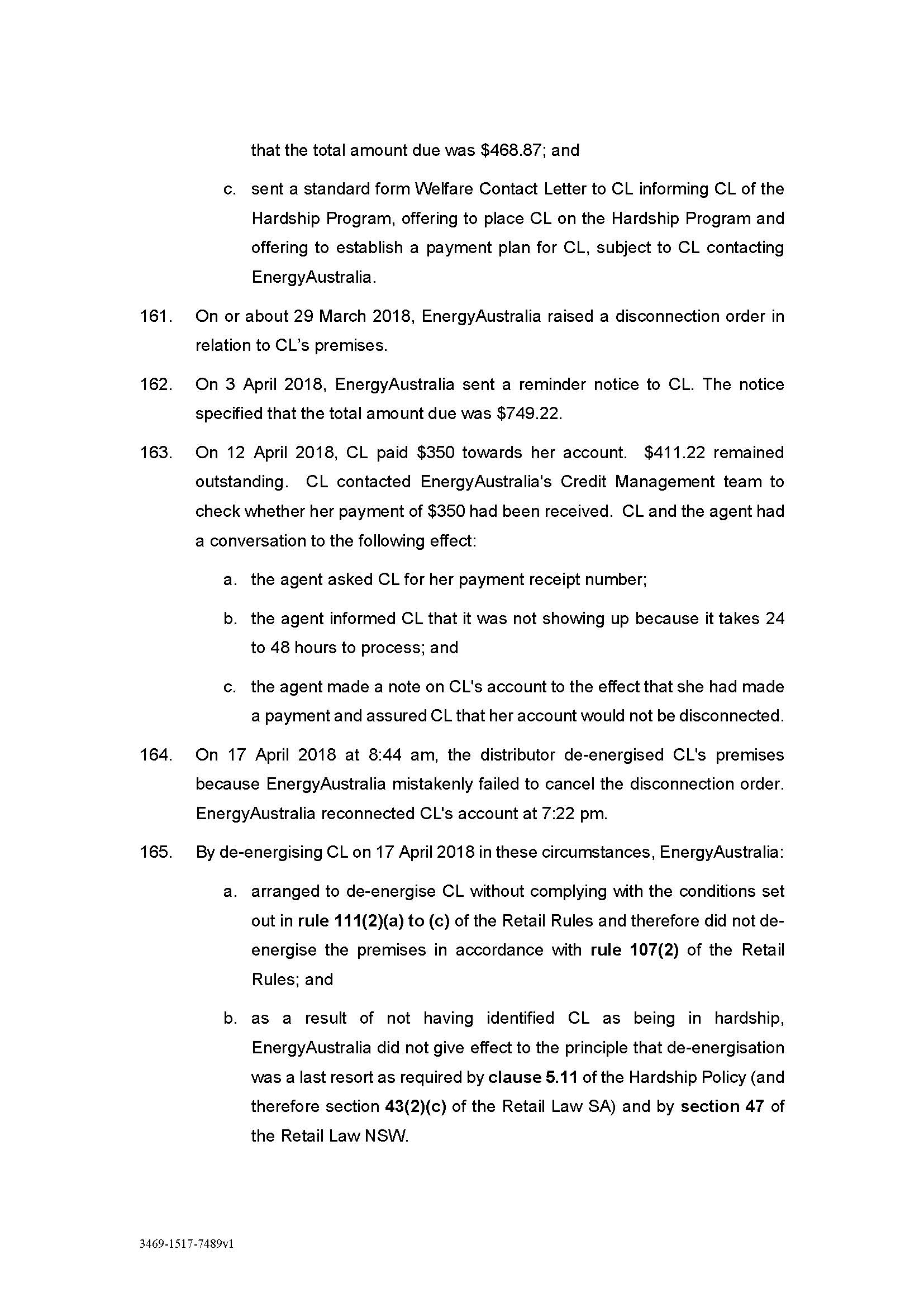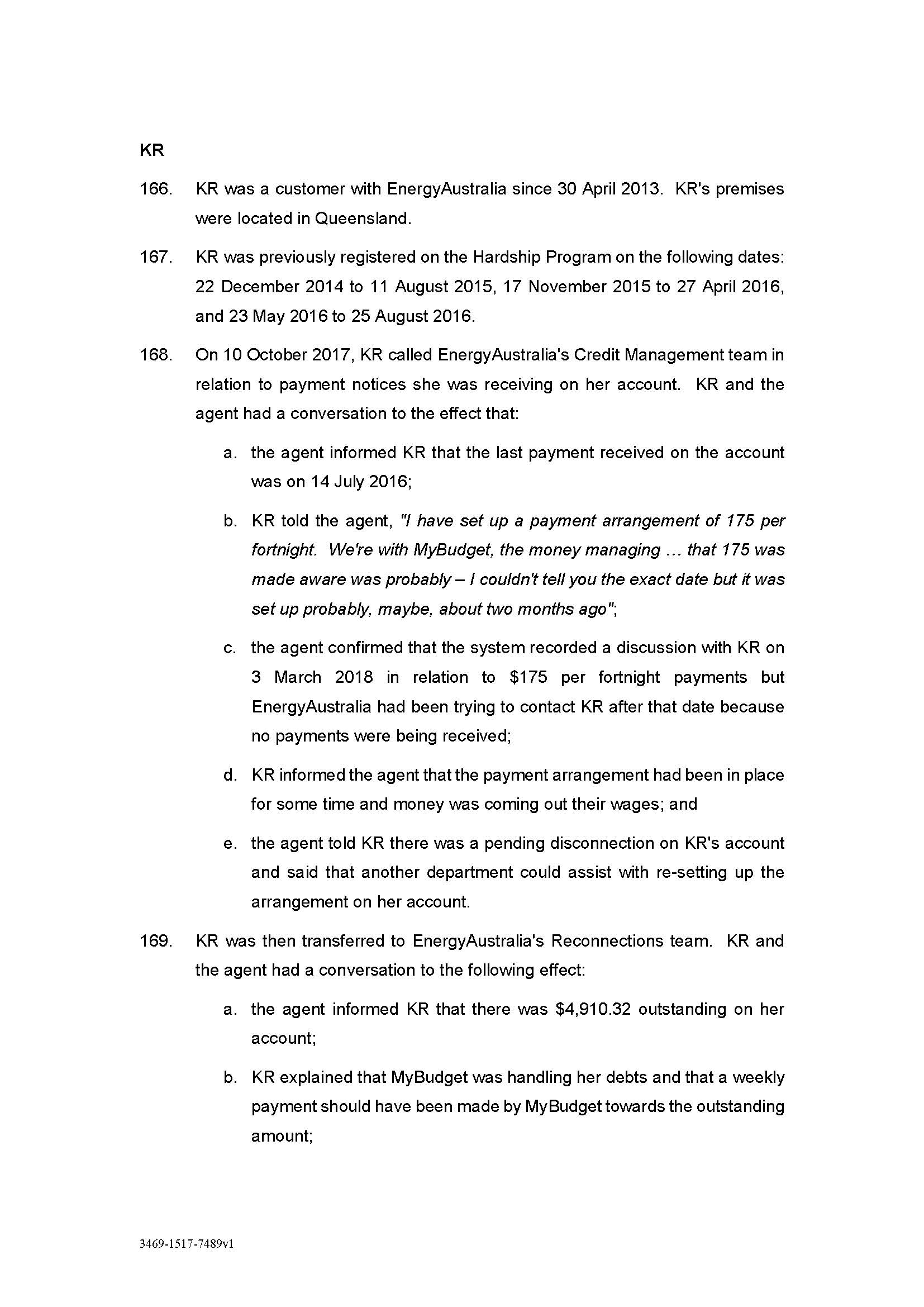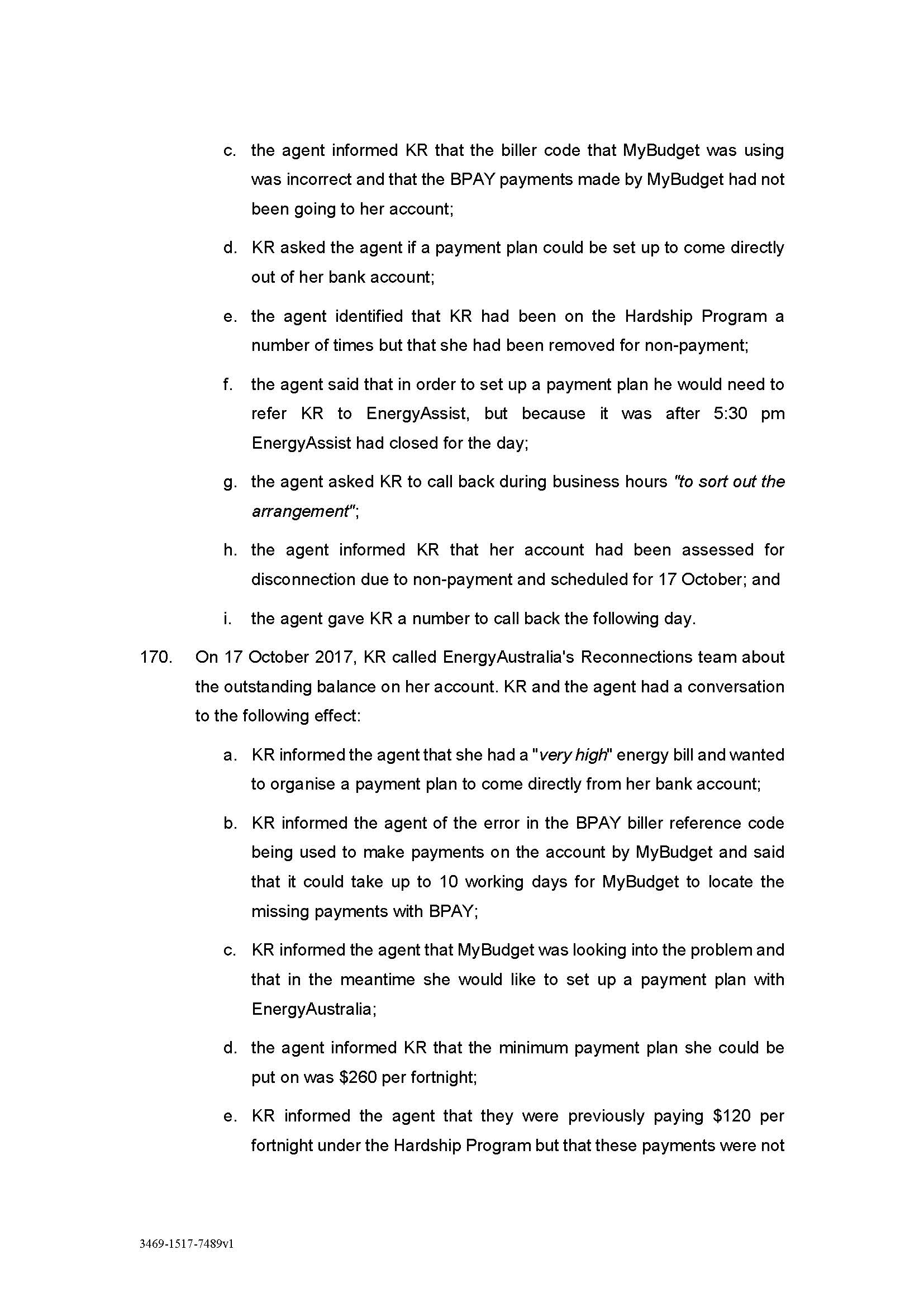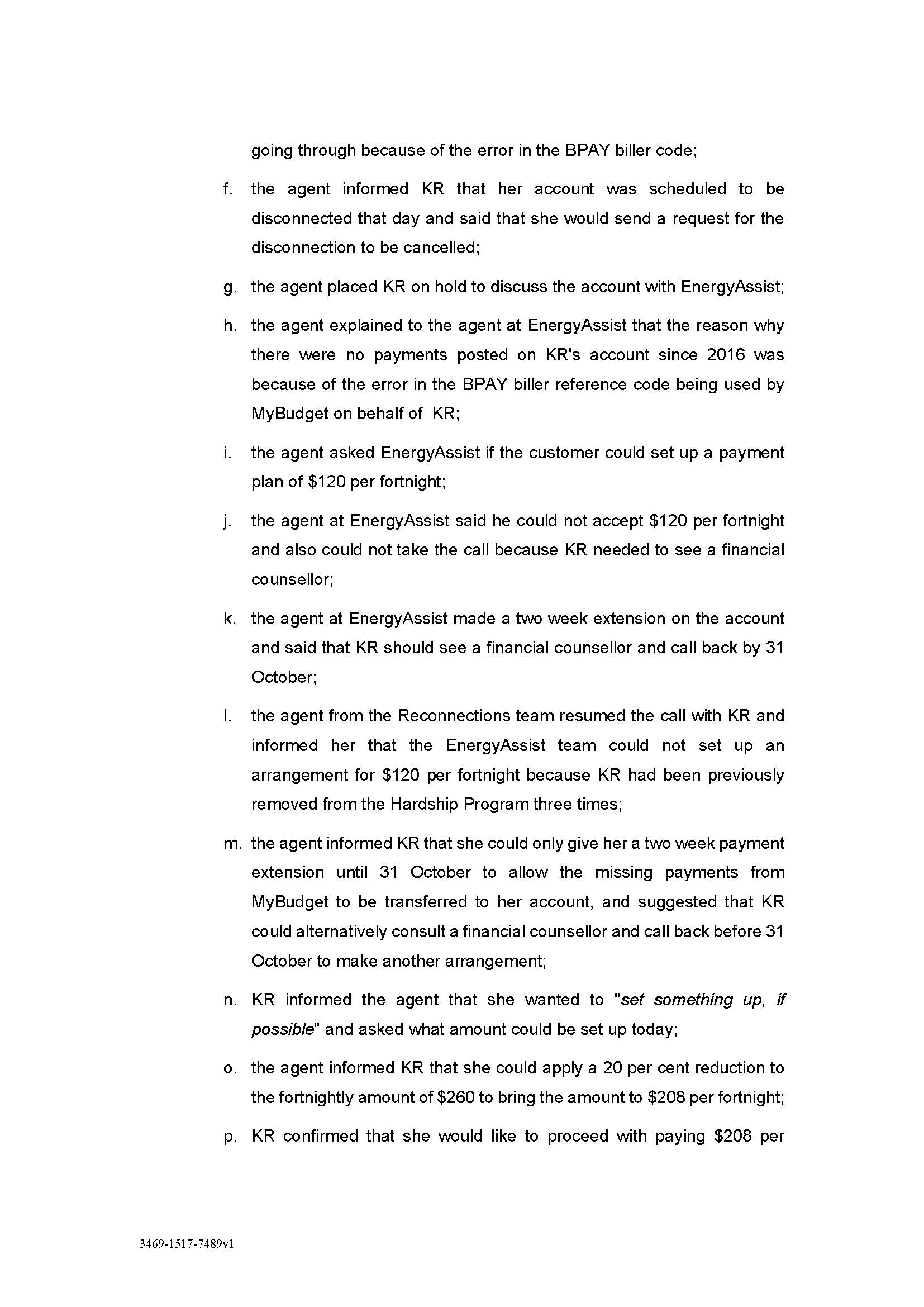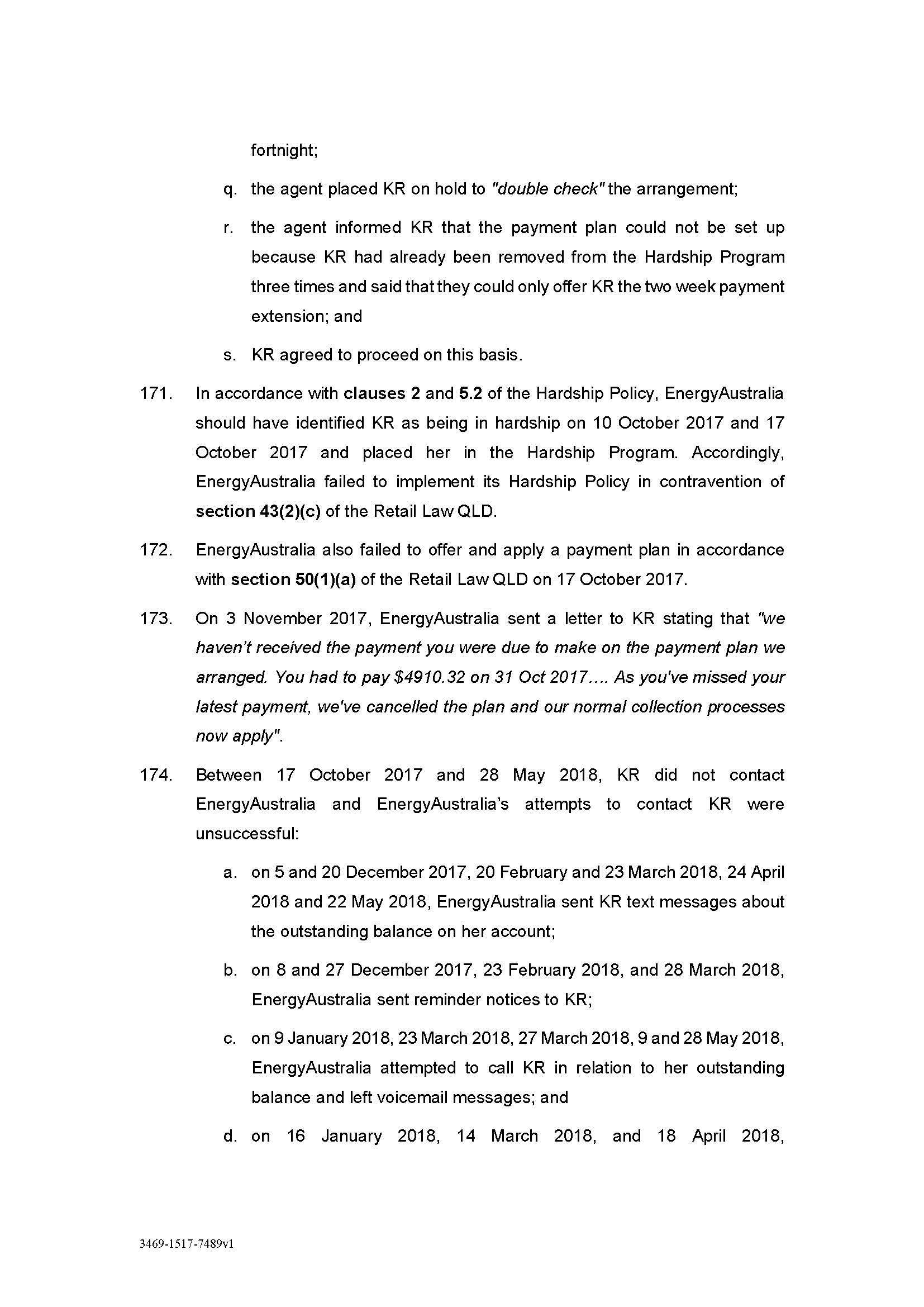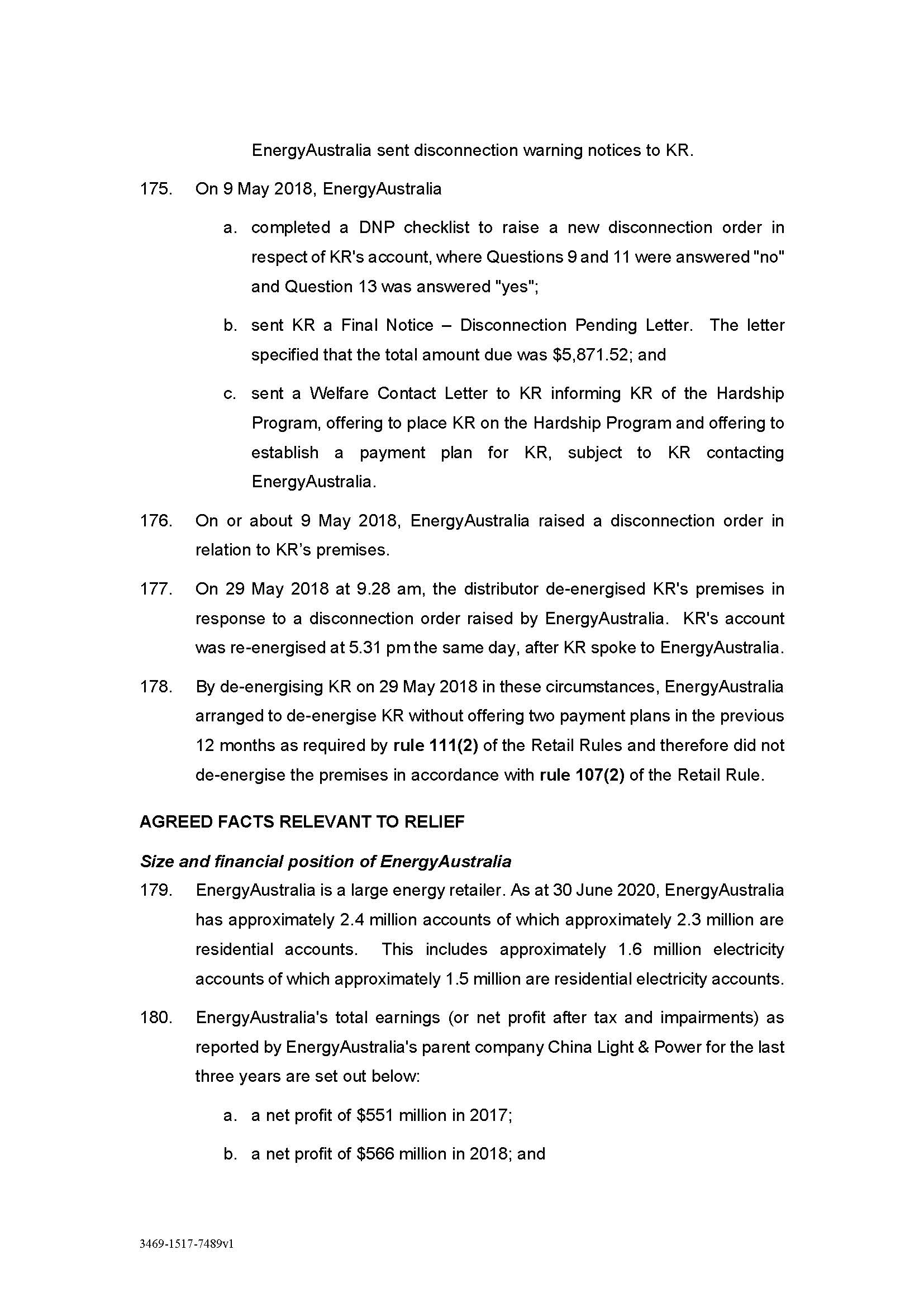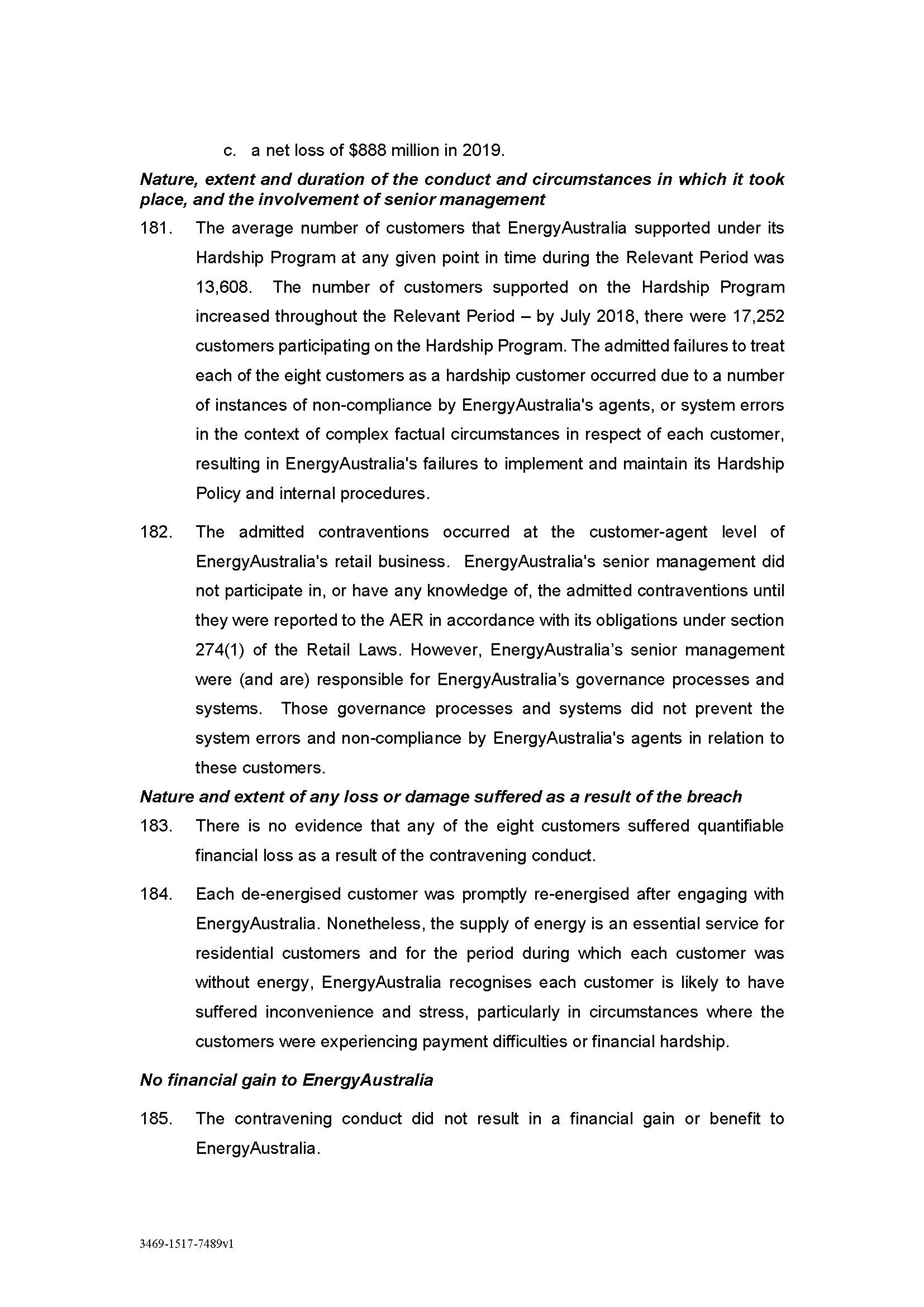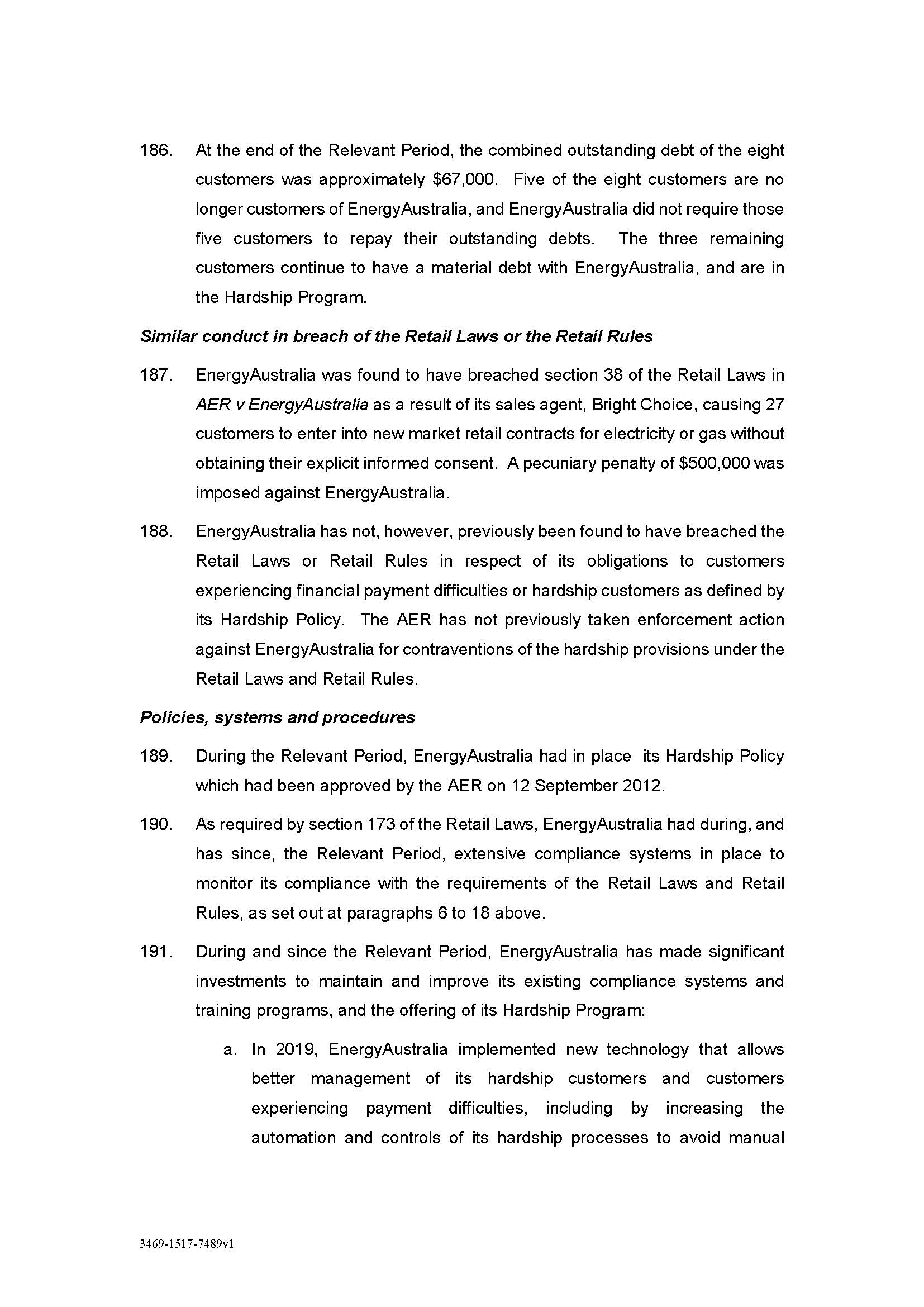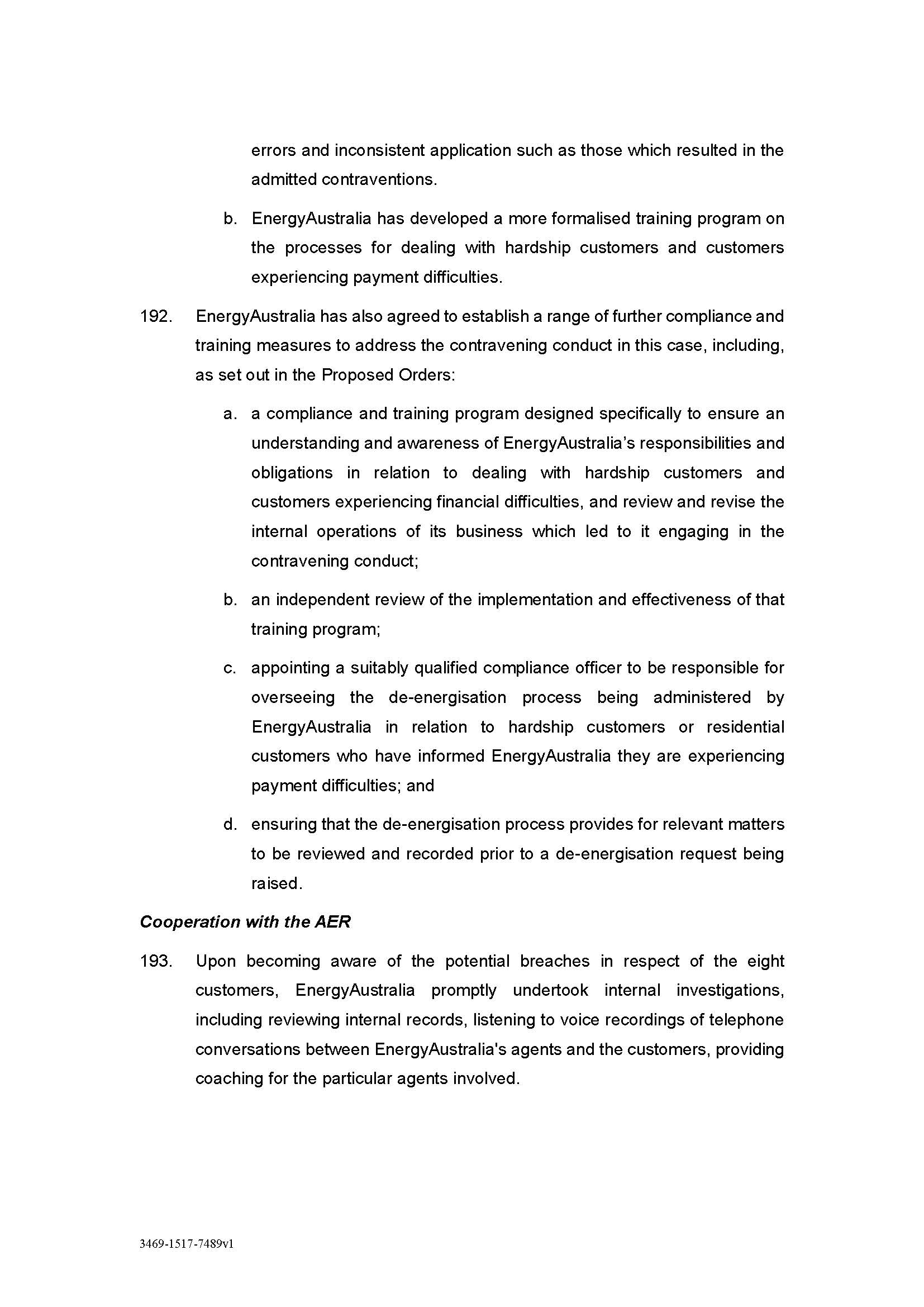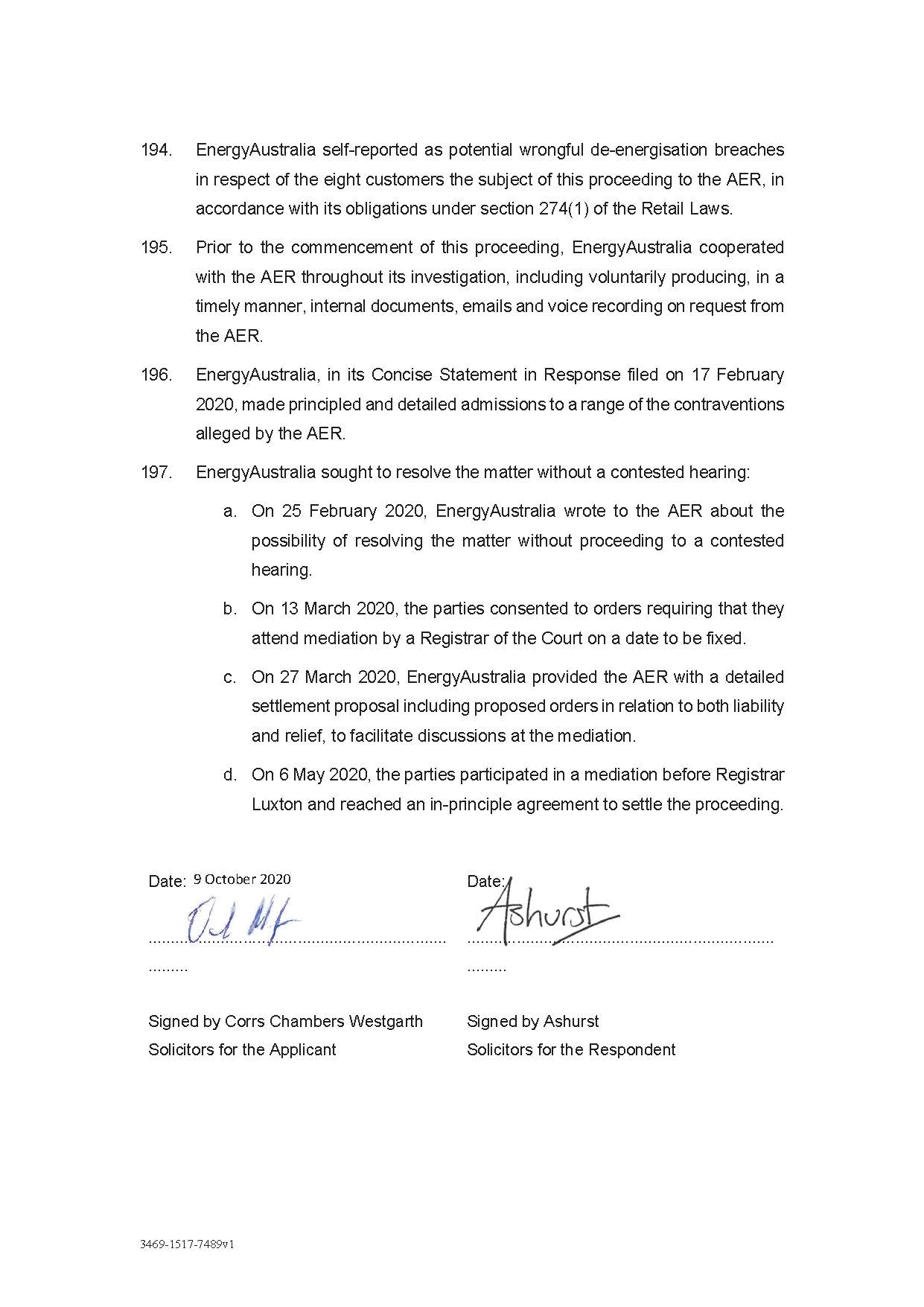Federal Court of Australia
Australian Energy Regulator v EnergyAustralia Pty Ltd [2020] FCA 1647
ORDERS
Applicant | ||
AND: | ENERGYAUSTRALIA PTY LTD (ACN 086 014 968) Respondent | |
DATE OF ORDER: |
THE COURT NOTES THAT:
For the purposes of the declarations and orders that follow, the relevant State/Territory energy laws are referred to as follows:
a. Retail Law means Schedule 1 to the National Energy Retail Law (South Australia) Act 2011 (SA) (SA Act), which contains the uniform energy law known as the National Energy Retail Law;
b. Retail Laws means the Retail Law SA, Retail Law NSW and Retail Law Qld as defined below;
c. Retail Rules means the National Energy Retail Rules made pursuant to s 238 of the Retail Law and adopted in the relevant State/Territory energy laws referred to below;
d. Retail Law SA means the National Energy Retail Law (South Australia), which, by virtue of s 4 of the SA Act, applies the Retail Law in the state of South Australia as implemented by the SA Act. Sections 2, 3 and 15 of the Retail Law SA apply the Retail Rules in the state of South Australia;
e. Retail Law NSW means the National Energy Retail Law (NSW), which, by virtue of s 4 of the National Energy Retail Law (Adoption) Act 2012 (NSW) (NSW Act), applies the Retail Law in the state of New South Wales with the modifications set out in Sch 1 of the NSW Act. Sections 2, 3 and 15 of the Retail Law NSW apply the Retail Rules in the state of New South Wales; and
f. Retail Law Qld means the National Energy Retail Law (Queensland), which by virtue of s 4 of the National Energy Retail Law (Queensland) Act 2014 (Qld Act), applies the Retail Law in the state of Queensland with the modifications set out in the schedule to the Qld Act, or as prescribed by regulation under s 12 of the Qld Act. Sections 2, 3 and 15 of the Retail Law Qld apply the Retail Rules in the state of Queensland.
THE COURT DECLARES THAT:
1. Between 27 December 2017 and 28 May 2018, the respondent (EnergyAustralia) failed to treat a customer in South Australia (DF) as a hardship customer within the meaning of EnergyAustralia’s customer hardship policy issued in September 2012 (customer hardship policy) and wrongfully de-energised DF on 28 May 2018. EnergyAustralia thereby contravened:
(a) s 43(2)(c) of the Retail Law SA by failing to maintain and implement clauses of its customer hardship policy in respect of DF, in particular:
(i) clauses 2 and 5.2 between 27 December 2017 and 28 May 2018;
(ii) clause 5.4 on 27 December 2017, 12 April 2018 and 28 May 2018; and
(iii) clause 5.11 on 28 May 2018;
(b) s 47 of the Retail Law SA by failing to give effect to the principle that the de-energisation of DF’s premises on 28 May 2018 was a last resort;
(c) s 46 of the Retail Law SA and rule 71(1) of the Retail Rules by failing to inform DF of EnergyAustralia’s customer hardship policy on or after 27 December 2017;
(d) s 50(1)(a) of the Retail Law SA by failing to offer and apply a payment plan to DF on 12 April 2018 and 28 May 2018;
(e) s 50(2) of the Retail Law SA by failing to comply with the applicable requirements of the Retail Rules in relation to payment plans in accordance with rule 72(1) of the Retail Rules on 27 December 2017; and
(f) rule 107(2) of the Retail Rules by arranging to de-energise DF’s premises on 28 May 2018, but failing to offer DF two payment plans in the previous 12 months as required by rule 111(2).
2. Between 11 May 2017 and 12 March 2018, EnergyAustralia failed to treat a customer in New South Wales (JS) as a hardship customer within the meaning of EnergyAustralia’s customer hardship policy and wrongfully de-energised JS on 16 May 2017 and 12 March 2018. EnergyAustralia thereby contravened:
(a) s 43(2)(c) of the Retail Law NSW by failing to maintain and implement clauses of its customer hardship policy in respect of JS, in particular:
(i) clauses 2 and 5.2 between 11 May 2017 and 12 March 2018;
(ii) clause 5.4 on 4 September 2017; and
(iii) clause 5.11 on 16 May 2017 and 12 March 2018;
(b) s 47 of the Retail Law NSW by failing to give effect to the principle that the de-energisation of JS’s premises on 16 May 2017 and 12 March 2018 was a last resort;
(c) s 46 of the Retail Law NSW and rule 71(1) of the Retail Rules by failing to inform JS of EnergyAustralia’s customer hardship policy on or after 11 May 2017;
(d) s 50(2) of the Retail Law NSW by failing to comply with the applicable requirements of the Retail Rules in relation to payment plans in accordance with rule 72(1) of the Retail Rules on 4 September 2017;
(e) s 50(2) of the Retail Law NSW by failing to comply with rule 72(2) of the Retail Rules on 4 September 2017 by failing to inform JS of the duration of a plan and the number of instalments to pay in arrears;
(f) rule 107(2) of the Retail Rules by arranging to de-energise JS’s premises on 16 May 2017 and 12 March 2018 but failing to offer JS two payment plans in the previous 12 months as required by rule 111(2); and
(g) rule 116(1)(d) of the Retail Rules by arranging to de-energise JS’s premises on or before 16 May 2017 when she was adhering to a payment plan.
3. Between 21 March 2017 and 13 November 2017, EnergyAustralia failed to treat a customer in South Australia (AH) as a hardship customer within the meaning of EnergyAustralia’s customer hardship policy and wrongfully de-energised AH on 13 November 2017. EnergyAustralia thereby contravened:
(a) s 43(2)(c) of the Retail Law SA by failing to maintain and implement clauses of its customer hardship policy in respect of AH, in particular:
(i) clauses 2 and 5.2 between 21 March 2017 and 13 November 2017; and
(ii) clause 5.4 on 21 March 2017;
(b) s 46 of the Retail Law SA and rule 71(1) of the Retail Rules by failing to inform AH of EnergyAustralia’s customer hardship policy on or after 21 March 2017;
(c) s 50(2) of the Retail Law SA by failing to comply with the applicable requirements of the Retail Rules in relation to payment plans in accordance with rule 72(1) of the Retail Rules on 21 March 2017; and
(d) rule 107(2) of the Retail Rules by arranging to de-energise AH’s premises on 13 November 2017, but failing to offer AH two payment plans in the previous 12 months as required by rule 111(2).
4. Between 17 November 2017 and 12 April 2018, EnergyAustralia failed to treat a customer in South Australia (MJ) as a hardship customer within the meaning of EnergyAustralia’s customer hardship policy and wrongfully de-energised MJ on 12 April 2018. EnergyAustralia thereby contravened:
(a) s 43(2)(c) of the Retail Law SA by failing to maintain and implement clauses 2 and 5.2 of its customer hardship policy in respect of MJ between 17 November 2017 and 12 April 2018;
(b) s 46 of the Retail Law SA and rule 71(1) of the Retail Rules by failing to inform MJ of EnergyAustralia’s customer hardship policy on or after 17 November 2017;
(c) s 50(1)(a) of the Retail Law SA by failing to offer and apply a payment plan to MJ on 17 November 2017; and
(d) rule 107(2) of the Retail Rules by arranging to de-energise MJ’s premises on 12 April 2018, but failing to offer MJ two payment plans in the previous 12 months as required by rule 111(2).
5. Between 7 September 2016 and 4 July 2018, EnergyAustralia failed to treat a customer in South Australia (DH) as a hardship customer within the meaning of EnergyAustralia’s customer hardship policy or otherwise apply its hardship policy and wrongfully de-energised DH on 4 July 2018. EnergyAustralia thereby contravened:
(a) s 43(2)(c) of the Retail Law SA by failing to maintain and implement clauses of its customer hardship policy in respect of DH, in particular:
(i) clauses 2 and 5.2 between 1 June 2017 and 4 July 2018;
(ii) clause 5.4 on 7 September 2016 and 1 June 2017; and
(iii) clause 5.11 on 4 July 2018;
(b) s 47 of the Retail Law SA by failing to give effect to the principle that the de-energisation of DH’s premises on 4 July 2018 was a last resort;
(c) s 50(2) of the Retail Law SA by failing to comply with the applicable requirements of the Retail Rules in relation to payment plans in accordance with rule 72(1) of the Retail Rules on 7 September 2016 and 1 June 2017; and
(d) rule 107(2) of the Retail Rules by arranging to de-energise DH’s premises on 4 July 2018, but failing to offer DH two payment plans in the previous 12 months as required by rule 111(2).
6. Between 4 January 2018 and 4 April 2018, EnergyAustralia failed to treat a customer in New South Wales (MM) as a hardship customer within the meaning of EnergyAustralia’s customer hardship policy and wrongfully de-energised MM on 4 April 2018. EnergyAustralia thereby contravened:
(a) s 43(2)(c) of the Retail Law NSW by failing to maintain and implement clauses of its customer hardship policy in respect of MM, in particular:
(i) clauses 2 and 5.2 between 4 January 2018 and 4 April 2018; and
(ii) clause 5.11 on 4 April 2018;
(b) s 47 of the Retail Law NSW by failing to give effect to the principle that the de-energisation of MM’s premises on 4 April 2018 was a last resort;
(c) s 50(1)(a) of the Retail Law NSW by failing to offer and apply a payment plan to MM on 4 January 2018; and
(d) rule 107(2) of the Retail Rules by arranging to de-energise MM’s premises on 4 April 2018, but failing to offer MM two payment plans in the previous 12 months as required by rule 111(2).
7. Between 23 October 2017 and 17 April 2018, EnergyAustralia failed to treat a customer in New South Wales (CL) as a hardship customer within the meaning of EnergyAustralia’s customer hardship policy and wrongfully de-energised CL on 17 April 2018. EnergyAustralia thereby contravened:
(a) s 43(2)(c) of the Retail Law NSW by failing to maintain and implement clauses of its customer hardship policy in respect of CL, in particular:
(i) clauses 2 and 5.2 between 23 October 2017 and 17 April 2018;
(ii) clause 5.4 on 9 November 2017 and 6 February 2018; and
(iii) clause 5.11 on 17 April 2018;
(b) s 47 of the Retail Law NSW by failing to give effect to the principle that the de-energisation of CL’s premises on 17 April 2018 was a last resort;
(c) s 46 of the Retail Law NSW and rule 71(1) of the Retail Rules by failing to inform CL of EnergyAustralia’s customer hardship policy on or after 23 October 2017;
(d) s 50(2) of the Retail Law NSW by failing to comply with the applicable requirements of the Retail Rules in relation to payment plans in accordance with rule 72(1) of the Retail Rules on 9 November 2017 and 6 February 2018; and
(e) rule 107(2) of the Retail Rules by arranging to de-energise CL on 17 April 2018 but failing to comply with the conditions set out in rule 111(2)(a) to (c).
8. Between 10 October 2017 and 29 May 2018, EnergyAustralia failed to treat a customer in Queensland (KR) as a hardship customer within the meaning of EnergyAustralia’s customer hardship policy and wrongfully de-energised KR on 29 May 2018. EnergyAustralia thereby contravened:
(a) s 43(2)(c) of the Retail Law Qld by failing to maintain and implement clauses 2 and 5.2 of its customer hardship policy in respect of KR between 10 October 2017 and 29 May 2018;
(b) s 50(1)(a) of the Retail Law Qld by failing to offer and apply a payment plan to KR on 17 October 2017; and
(c) rule 107(2) of the Retail Rules by arranging to de-energise KR’s premises on 29 May 2018, but failing to offer KR two payment plans in the previous 12 months as required by rule 111(2).
THE COURT ORDERS THAT:
9. EnergyAustralia must:
(a) within 90 days of this order, establish a compliance and training program which is specifically designed to:
(i) ensure an understanding and awareness of EnergyAustralia’s responsibilities and obligations in relation to dealing with hardship customers and customers experiencing financial difficulties, with particular emphasis on the requirements of ss 43(2)(c), 46, 47, 50(1) and 50(2) of the Retail Laws, and rules 71(1), 72(1), 72(2), 107(2), 111(2) and 116(1)(d) of the Retail Rules; and
(ii) review and revise the internal operations of its business which led to it engaging in the conduct declared by the Court in this proceeding to be in breach of ss 43(2)(c), 46, 47, 50(1) and 50(2) of the Retail Laws, and rules 71(1), 72(1), 72(2), 107(2), 111(2) and 116(1)(d) of the Retail Rules;
(b) maintain and administer at its own expense the compliance and training program referred to in paragraph 9(a), for a period of three years;
(c) at its own expense, appoint a suitably qualified compliance professional (the Reviewer) with expertise in the national energy laws, who is independent and whose appointment has been approved by the applicant (AER), to conduct a review of the implementation and effectiveness of the compliance and training program referred to in paragraph 9(a) annually for three years, commencing 12 months after the date of this order and to prepare a written report to be provided to EnergyAustralia within 60 days of the commencement of each review. The appointed Reviewer may be replaced by EnergyAustralia if necessary, with the prior approval of the AER;
(d) ensure that the Reviewer will be independent for the purposes of paragraph 9(c) by only appointing a Reviewer that:
(i) did not design or implement the compliance and training program referred to in paragraph 9(a);
(ii) is not a current employee, contractor or director of EnergyAustralia or any related body corporate, and has not been an employee, contractor or director of EnergyAustralia or any related body corporate in the past five years;
(iii) has not represented and does not represent and does not consult and has not consulted for EnergyAustralia in any energy regulatory or consumer matters; and
(iv) has no significant shareholding or other interests in EnergyAustralia or any related body corporate,
unless a nominated Reviewer is approved by the AER;
(e) use its best endeavours to provide the Reviewer with access to all sources of information within the possession, power or control of EnergyAustralia or any related body corporate that is relevant to the review;
(f) within 30 days after receiving the Reviewer’s written report provide a copy of that report to the AER and the board of directors of EnergyAustralia Holdings Limited (ACN 101 876 135); and
(g) implement promptly and with due diligence any recommendations made by the Reviewer (unless the AER consents to a request by EnergyAustralia not to do so, acting reasonably) and advise the AER in writing of the implementation.
10. EnergyAustralia must, for three years commencing 90 days after the date of this order, adopt the following actions and practices to prevent the recurrence of the breaches which are the subject of declarations in this proceeding:
(a) within 90 days of the date of this order, appoint a compliance officer to be responsible for ensuring that the de-energisation process implemented by EnergyAustralia in relation to hardship customers or residential customers who have informed EnergyAustralia they are experiencing payment difficulties, complies with the requirements of this order, and ensuring that a suitably qualified person carries out the role of compliance officer for the period of three years from the date of this order;
(b) design, implement and maintain in operation a process to be completed by EnergyAustralia staff prior to any de-energisation of a customer described in paragraph 10(a) which confirms that:
(i) the customer has been informed of EnergyAustralia’s hardship policy and, if the customer requested a copy, the customer has been provided with a copy of EnergyAustralia’s hardship policy;
(ii) EnergyAustralia has complied with its hardship policy with respect to the customer;
(iii) the customer has been offered two payment plans in the previous 12 months and, if so, whether the de-energisation can be approved if the customer:
A. has agreed to neither of them, or
B. has agreed to one but not the other, but the plan to which the customer agreed has been cancelled due to non-payment by the customer; or
C. has agreed to both but the plans have been cancelled due to non-payment by the customer;
(iv) the customer is not adhering to a payment plan; and
(v) the customer is being disconnected as a last resort.
For the purpose of this order, “payment plan” means a payment plan under rule 33 or 72 of the Retail Rules.
(c) ensure that the compliance officer:
(i) provides details of the process to the AER within 90 days of the date of this order and subsequently on request; and
(ii) reports annually to the board of directors of EnergyAustralia Holdings Limited (ACN 101 876 135) on compliance with the matters set out in paragraphs 10(a) and (b).
11. EnergyAustralia pay the Commonwealth of Australia a civil penalty in the sum of $1,500,000 within 30 days of the date of this order.
12. EnergyAustralia pay a contribution towards the applicant’s costs of and incidental to this proceeding, fixed in the sum of $100,000 within 30 days of the date of this order.
13. Pursuant to s 37AF of the Federal Court of Australia Act 1976 (Cth), on the ground that the order is necessary to prevent prejudice to the proper administration of justice, and until any further order is made, Confidential Schedule A to the applicant’s concise statement be kept confidential to the parties and not published.
14. As soon as reasonably practicable, the applicant file a complete version of its concise statement (including Confidential Schedule A), which document is to be kept confidential (and is not to be published) pursuant to paragraph 13 of these orders.
Note: Entry of orders is dealt with in Rule 39.32 of the Federal Court Rules 2011.
MOSHINSKY J:
Introduction
1 The respondent, EnergyAustralia Pty Ltd (EnergyAustralia) carries on a business of providing electricity and gas services to homes and is an authorised retailer of electricity and gas in several States of Australia. It supplies energy to approximately 2.4 million accounts of which 2.3 million are residential accounts and currently supports approximately 22,000 customers under its customer hardship program.
2 In accordance with s 43(2)(a) of the National Energy Retail Law as applicable in each of South Australia, NSW and Queensland (together, the Retail Laws), EnergyAustralia developed a hardship policy in respect of its residential customers (the Hardship Policy). The policy was approved by the applicant, the Australian Energy Regulator (the AER), on 12 September 2012. The Hardship Policy applied at all times during the period 7 September 2016 to 4 July 2018 (the relevant period).
3 The key feature of the Hardship Policy is EnergyAustralia’s customer hardship program, “EnergyAssist” (the Hardship Program). One of the main functions of the Hardship Program is to establish payment plans for hardship customers, as defined under the Hardship Policy.
4 The Hardship Program was open to “hardship customers”. Clause 2 of the Hardship Policy defined a “hardship customer” as a customer who was both willing to meet their financial obligations and unable to do so due to hardship. Customers who were not in financial hardship or were not willing to meet their financial obligations were not eligible for the Hardship Program, under clause 5.14 of the Hardship Policy.
5 Clause 5.1 of the Hardship Policy set out some of the ways that EnergyAustralia would identify customers in financial hardship. The strategies included using credit cycles designed to alert staff to poor payment history and a pattern of government assistance grants.
6 Section 47 of the Retail Laws sets out the general principle regarding de-energisation (or disconnection) of the premises of hardship customers, namely that disconnection due to the inability of the customer to pay energy bills “should be a last resort option”. In addition, clause 5.11 of the Hardship Policy provided that disconnection would only occur as a last resort and that EnergyAustralia would not disconnect any customer actively participating in the Hardship Program.
7 The AER is established by s 44AE of the Competition and Consumer Act 2010 (Cth). Its functions and powers are set out in s 204(1) of the Retail Laws and include investigating breaches of the Retail Laws and the National Energy Retail Rules (the Retail Rules) and instituting and conducting proceedings in relation to those breaches: ss 204(1)(c) and (d) of the Retail Laws. The AER has the power to institute civil proceedings in respect of a breach of the Retail Laws and the Retail Rules: s 289(2) of the Retail Laws.
8 The AER commenced this proceeding by originating application in November 2019. The AER sought declarations that EnergyAustralia had contravened provisions of the Retail Laws and the Retail Rules in its dealings with eight customers, who were identified by initials rather than by their full names. The AER also sought orders that EnergyAustralia pay a civil penalty, orders for a compliance program to prevent a recurrence of breaches, and an order that EnergyAustralia pay the AER’s costs.
9 By its concise statement, the AER alleged that EnergyAustralia had engaged in conduct that breached its obligations to hardship and residential customers under the Retail Laws and the Retail Rules, including because it failed to implement the Hardship Policy, failed to inform the customers of the Hardship Policy, failed to offer and apply payment plans (or appropriate payment plans), and wrongfully disconnected certain vulnerable customers. It was alleged that, at the time of the disconnection of the electricity supply, the customers were each experiencing severe difficulties in paying their accounts due to long-term or short-term financial hardship.
10 The AER and EnergyAustralia have reached an agreement regarding resolution of this proceeding. In summary, EnergyAustralia has admitted that, in its dealings with the eight customers, it contravened provisions of the Retail Laws and the Retail Rules. The parties jointly propose that the Court impose a civil penalty on EnergyAustralia of $1.5 million. The parties also jointly propose that certain additional orders be made regarding a compliance program and to prevent recurrence of breaches, and in relation to costs.
11 The parties have prepared a statement of agreed facts and admissions (SOAF), a copy of which appears as a schedule to these reasons. This includes, in relation to each of the eight customers, a detailed narration of the facts, and admissions by EnergyAustralia that it breached provisions of the Retail Laws and the Retail Rules.
12 The parties have provided an agreed minute of proposed orders. The proposed declarations (with the inclusion of a list of defined terms, based on the definitions in the originating application, and some other minor typographical adjustments) are as follows:
THE COURT NOTES THAT:
For the purposes of the declarations and orders that follow, the relevant State/Territory energy laws are referred to as follows:
a. Retail Law means Schedule 1 to the National Energy Retail Law (South Australia) Act 2011 (SA) (SA Act), which contains the uniform energy law known as the National Energy Retail Law;
b. Retail Laws means the Retail Law SA, Retail Law NSW and Retail Law Qld as defined below;
c. Retail Rules means the National Energy Retail Rules made pursuant to s 238 of the Retail Law and adopted in the relevant State/Territory energy laws referred to below;
d. Retail Law SA means the National Energy Retail Law (South Australia), which, by virtue of s 4 of the SA Act, applies the Retail Law in the state of South Australia as implemented by the SA Act. Sections 2, 3 and 15 of the Retail Law SA apply the Retail Rules in the state of South Australia;
e. Retail Law NSW means the National Energy Retail Law (NSW), which, by virtue of s 4 of the National Energy Retail Law (Adoption) Act 2012 (NSW) (NSW Act), applies the Retail Law in the state of New South Wales with the modifications set out in Sch 1 of the NSW Act. Sections 2, 3 and 15 of the Retail Law NSW apply the Retail Rules in the state of New South Wales; and
f. Retail Law Qld means the National Energy Retail Law (Queensland), which by virtue of s 4 of the National Energy Retail Law (Queensland) Act 2014 (Qld Act), applies the Retail Law in the state of Queensland with the modifications set out in the schedule to the Qld Act, or as prescribed by regulation under s 12 of the Qld Act. Sections 2, 3 and 15 of the Retail Law Qld apply the Retail Rules in the state of Queensland.
THE COURT DECLARES THAT:
1. Between 27 December 2017 and 28 May 2018, the respondent (EnergyAustralia) failed to treat a customer in South Australia (DF) as a hardship customer within the meaning of EnergyAustralia’s customer hardship policy issued in September 2012 (customer hardship policy) and wrongfully de-energised DF on 28 May 2018. EnergyAustralia thereby contravened:
a. s 43(2)(c) of the Retail Law SA by failing to maintain and implement clauses of its customer hardship policy in respect of DF, in particular:
i. clauses 2 and 5.2 between 27 December 2017 and 28 May 2018;
ii. clause 5.4 on 27 December 2017, 12 April 2018 and 28 May 2018; and
iii. clause 5.11 on 28 May 2018;
b. s 47 of the Retail Law SA by failing to give effect to the principle that the de-energisation of DF’s premises on 28 May 2018 was a last resort;
c. s 46 of the Retail Law SA and rule 71(1) of the Retail Rules by failing to inform DF of EnergyAustralia’s customer hardship policy on or after 27 December 2017;
d. s 50(1)(a) of the Retail Law SA by failing to offer and apply a payment plan to DF on 12 April 2018 and 28 May 2018;
e. s 50(2) of the Retail Law SA by failing to comply with the applicable requirements of the Retail Rules in relation to payment plans in accordance with rule 72(1) of the Retail Rules on 27 December 2017; and
f. rule 107(2) of the Retail Rules by arranging to de-energise DF’s premises on 28 May 2018, but failing to offer DF two payment plans in the previous 12 months as required by rule 111(2).
2. Between 11 May 2017 and 12 March 2018, EnergyAustralia failed to treat a customer in New South Wales (JS) as a hardship customer within the meaning of EnergyAustralia’s customer hardship policy and wrongfully de-energised JS on 16 May 2017 and 12 March 2018. EnergyAustralia thereby contravened:
a. s 43(2)(c) of the Retail Law NSW by failing to maintain and implement clauses of its customer hardship policy in respect of JS, in particular:
i. clauses 2 and 5.2 between 11 May 2017 and 12 March 2018;
ii. clause 5.4 on 4 September 2017; and
iii. clause 5.11 on 16 May 2017 and 12 March 2018;
b. s 47 of the Retail Law NSW by failing to give effect to the principle that the de-energisation of JS’s premises on 16 May 2017 and 12 March 2018 was a last resort;
c. s 46 of the Retail Law NSW and rule 71(1) of the Retail Rules by failing to inform JS of EnergyAustralia’s customer hardship policy on or after 11 May 2017;
d. s 50(2) of the Retail Law NSW by failing to comply with the applicable requirements of the Retail Rules in relation to payment plans in accordance with rule 72(1) of the Retail Rules on 4 September 2017;
e. s 50(2) of the Retail Law NSW by failing to comply with rule 72(2) of the Retail Rules on 4 September 2017 by failing to inform JS of the duration of a plan and the number of instalments to pay in arrears;
f. rule 107(2) of the Retail Rules by arranging to de-energise JS’s premises on 16 May 2017 and 12 March 2018 but failing to offer JS two payment plans in the previous 12 months as required by rule 111(2); and
g. rule 116(1)(d) of the Retail Rules by arranging to de-energise JS’s premises on or before 16 May 2017 when she was adhering to a payment plan.
3. Between 21 March 2017 and 13 November 2017, EnergyAustralia failed to treat a customer in South Australia (AH) as a hardship customer within the meaning of EnergyAustralia’s customer hardship policy and wrongfully de-energised AH on 13 November 2017. EnergyAustralia thereby contravened:
a. s 43(2)(c) of the Retail Law SA by failing to maintain and implement clauses of its customer hardship policy in respect of AH, in particular:
i. clauses 2 and 5.2 between 21 March 2017 and 13 November 2017; and
ii. clause 5.4 on 21 March 2017;
b. s 46 of the Retail Law SA and rule 71(1) of the Retail Rules by failing to inform AH of EnergyAustralia’s customer hardship policy on or after 21 March 2017;
c. s 50(2) of the Retail Law SA by failing to comply with the applicable requirements of the Retail Rules in relation to payment plans in accordance with rule 72(1) of the Retail Rules on 21 March 2017; and
d. rule 107(2) of the Retail Rules by arranging to de-energise AH’s premises on 13 November 2017, but failing to offer AH two payment plans in the previous 12 months as required by rule 111(2).
4. Between 17 November 2017 and 12 April 2018, EnergyAustralia failed to treat a customer in South Australia (MJ) as a hardship customer within the meaning of EnergyAustralia’s customer hardship policy and wrongfully de-energised MJ on 12 April 2018. EnergyAustralia thereby contravened:
a. s 43(2)(c) of the Retail Law SA by failing to maintain and implement clauses 2 and 5.2 of its customer hardship policy in respect of MJ between 17 November 2017 and 12 April 2018;
b. s 46 of the Retail Law SA and rule 71(1) of the Retail Rules by failing to inform MJ of EnergyAustralia’s customer hardship policy on or after 17 November 2017;
c. s 50(1)(a) of the Retail Law SA by failing to offer and apply a payment plan to MJ on 17 November 2017; and
d. rule 107(2) of the Retail Rules by arranging to de-energise MJ’s premises on 12 April 2018, but failing to offer MJ two payment plans in the previous 12 months as required by rule 111(2).
5. Between 7 September 2016 and 4 July 2018, EnergyAustralia failed to treat a customer in South Australia (DH) as a hardship customer within the meaning of EnergyAustralia’s customer hardship policy or otherwise apply its hardship policy and wrongfully de-energised DH on 4 July 2018. EnergyAustralia thereby contravened:
a. s 43(2)(c) of the Retail Law SA by failing to maintain and implement clauses of its customer hardship policy in respect of DH, in particular:
i. clauses 2 and 5.2 between 1 June 2017 and 4 July 2018;
ii. clause 5.4 on 7 September 2016 and 1 June 2017; and
iii. clause 5.11 on 4 July 2018;
b. s 47 of the Retail Law SA by failing to give effect to the principle that the de-energisation of DH’s premises on 4 July 2018 was a last resort;
c. s 50(2) of the Retail Law SA by failing to comply with the applicable requirements of the Retail Rules in relation to payment plans in accordance with rule 72(1) of the Retail Rules on 7 September 2016 and 1 June 2017; and
d. rule 107(2) of the Retail Rules by arranging to de-energise DH’s premises on 4 July 2018, but failing to offer DH two payment plans in the previous 12 months as required by rule 111(2).
6. Between 4 January 2018 and 4 April 2018, EnergyAustralia failed to treat a customer in New South Wales (MM) as a hardship customer within the meaning of EnergyAustralia’s customer hardship policy and wrongfully de-energised MM on 4 April 2018. EnergyAustralia thereby contravened:
a. s 43(2)(c) of the Retail Law NSW by failing to maintain and implement clauses of its customer hardship policy in respect of MM, in particular:
i. clauses 2 and 5.2 between 4 January 2018 and 4 April 2018; and
ii. clause 5.11 on 4 April 2018;
b. s 47 of the Retail Law NSW by failing to give effect to the principle that the de-energisation of MM’s premises on 4 April 2018 was a last resort;
c. s 50(1)(a) of the Retail Law NSW by failing to offer and apply a payment plan to MM on 4 January 2018; and
d. rule 107(2) of the Retail Rules by arranging to de-energise MM’s premises on 4 April 2018, but failing to offer MM two payment plans in the previous 12 months as required by rule 111(2).
7. Between 23 October 2017 and 17 April 2018, EnergyAustralia failed to treat a customer in New South Wales (CL) as a hardship customer within the meaning of EnergyAustralia’s customer hardship policy and wrongfully de-energised CL on 17 April 2018. EnergyAustralia thereby contravened:
a. s 43(2)(c) of the Retail Law NSW by failing to maintain and implement clauses of its customer hardship policy in respect of CL, in particular:
i. clauses 2 and 5.2 between 23 October 2017 and 17 April 2018;
ii. clause 5.4 on 9 November 2017 and 6 February 2018; and
iii. clause 5.11 on 17 April 2018;
b. s 47 of the Retail Law NSW by failing to give effect to the principle that the de-energisation of CL’s premises on 17 April 2018 was a last resort;
c. s 46 of the Retail Law NSW and rule 71(1) of the Retail Rules by failing to inform CL of EnergyAustralia’s customer hardship policy on or after 23 October 2017;
d. s 50(2) of the Retail Law NSW by failing to comply with the applicable requirements of the Retail Rules in relation to payment plans in accordance with rule 72(1) of the Retail Rules on 9 November 2017 and 6 February 2018; and
e. rule 107(2) of the Retail Rules by arranging to de-energise CL on 17 April 2018 but failing to comply with the conditions set out in rule 111(2)(a) to (c).
8. Between 10 October 2017 and 29 May 2018, EnergyAustralia failed to treat a customer in Queensland (KR) as a hardship customer within the meaning of EnergyAustralia’s customer hardship policy and wrongfully de-energised KR on 29 May 2018. EnergyAustralia thereby contravened:
a. s 43(2)(c) of the Retail Law Qld by failing to maintain and implement clauses 2 and 5.2 of its customer hardship policy in respect of KR between 10 October 2017 and 29 May 2018;
b. s 50(1)(a) of the Retail Law Qld by failing to offer and apply a payment plan to KR on 17 October 2017; and
c. rule 107(2) of the Retail Rules by arranging to de-energise KR’s premises on 29 May 2018, but failing to offer KR two payment plans in the previous 12 months as required by rule 111(2).
13 The proposed orders are as follows:
9. EnergyAustralia must:
a. within 90 days of this order, establish a compliance and training program which is specifically designed to:
i. ensure an understanding and awareness of EnergyAustralia’s responsibilities and obligations in relation to dealing with hardship customers and customers experiencing financial difficulties, with particular emphasis on the requirements of ss 43(2)(c), 46, 47, 50(1) and 50(2) of the Retail Laws, and rules 71(1), 72(1), 72(2), 107(2), 111(2) and 116(1)(d) of the Retail Rules; and
ii. review and revise the internal operations of its business which led to it engaging in the conduct declared by the Court in this proceeding to be in breach of ss 43(2)(c), 46, 47, 50(1) and 50(2) of the Retail Laws, and rules 71(1), 72(1), 72(2), 107(2), 111(2) and 116(1)(d) of the Retail Rules;
b. maintain and administer at its own expense the compliance and training program referred to in paragraph 9(a), for a period of three years;
c. at its own expense, appoint a suitably qualified compliance professional (the Reviewer) with expertise in the national energy laws, who is independent and whose appointment has been approved by the applicant (AER), to conduct a review of the implementation and effectiveness of the compliance and training program referred to in paragraph 9(a) annually for three years, commencing 12 months after the date of this order and to prepare a written report to be provided to EnergyAustralia within 60 days of the commencement of each review. The appointed Reviewer may be replaced by EnergyAustralia if necessary, with the prior approval of the AER;
d. ensure that the Reviewer will be independent for the purposes of paragraph 9(c) by only appointing a Reviewer that:
i. did not design or implement the compliance and training program referred to in paragraph 9(a);
ii. is not a current employee, contractor or director of EnergyAustralia or any related body corporate, and has not been an employee, contractor or director of EnergyAustralia or any related body corporate in the past five years;
iii. has not represented and does not represent and does not consult and has not consulted for EnergyAustralia in any energy regulatory or consumer matters; and
iv. has no significant shareholding or other interests in EnergyAustralia or any related body corporate,
unless a nominated Reviewer is approved by the AER;
e. use its best endeavours to provide the Reviewer with access to all sources of information within the possession, power or control of EnergyAustralia or any related body corporate that is relevant to the review;
f. within 30 days after receiving the Reviewer’s written report provide a copy of that report to the AER and the board of directors of EnergyAustralia Holdings Limited (ACN 101 876 135); and
g. implement promptly and with due diligence any recommendations made by the Reviewer (unless the AER consents to a request by EnergyAustralia not to do so, acting reasonably) and advise the AER in writing of the implementation.
10. EnergyAustralia must, for three years commencing 90 days after the date of this order, adopt the following actions and practices to prevent the recurrence of the breaches which are the subject of declarations in this proceeding:
a. within 90 days of the date of this order, appoint a compliance officer to be responsible for ensuring that the de-energisation process implemented by EnergyAustralia in relation to hardship customers or residential customers who have informed EnergyAustralia they are experiencing payment difficulties, complies with the requirements of this order, and ensuring that a suitably qualified person carries out the role of compliance officer for the period of three years from the date of this order;
b. design, implement and maintain in operation a process to be completed by EnergyAustralia staff prior to any de-energisation of a customer described in paragraph 10(a) which confirms that:
i. the customer has been informed of EnergyAustralia’s hardship policy and, if the customer requested a copy, the customer has been provided with a copy of EnergyAustralia’s hardship policy;
ii. EnergyAustralia has complied with its hardship policy with respect to the customer;
iii. the customer has been offered two payment plans in the previous 12 months and, if so, whether the de-energisation can be approved if the customer:
(A) has agreed to neither of them, or
(B) has agreed to one but not the other, but the plan to which the customer agreed has been cancelled due to non-payment by the customer; or
(C) has agreed to both but the plans have been cancelled due to non-payment by the customer;
iv. the customer is not adhering to a payment plan; and
v. the customer is being disconnected as a last resort.
For the purpose of this order, “payment plan” means a payment plan under rule 33 or 72 of the Retail Rules.
c. ensure that the compliance officer:
i. provides details of the process to the AER within 90 days of the date of this order and subsequently on request; and
ii. reports annually to the board of directors of EnergyAustralia Holdings Limited (ACN 101 876 135) on compliance with the matters set out in paragraphs 10(a) and (b).
11. EnergyAustralia pay the Commonwealth of Australia a civil penalty in the sum of $1,500,000 within 30 days of the date of this order.
12. EnergyAustralia pay a contribution towards the applicant’s costs of and incidental to this proceeding, fixed in the sum of $100,000 within 30 days of the date of this order.
14 The parties provided a detailed joint submission in advance of the hearing. At the hearing today, which took place using Microsoft Teams video-conferencing software, due to the restrictions in place during the current coronavirus pandemic, the parties made oral submissions in support of the proposed declarations and orders.
15 For the reasons that follow, I consider there to be a proper basis for making the proposed declarations. I also consider the proposed civil penalty of $1.5 million to be appropriate and will make an order to this effect. This penalty reflects the circumstances of the contraventions and should operate as a deterrent against such conduct being engaged in by EnergyAustralia or by other energy retailers in the future.
16 I also consider it appropriate to make the other orders proposed by the parties.
Applicable principles and provisions
Making orders by agreement and declarations
17 The applicable principles as regards the making of orders by agreement and as regards declarations were summarised by Gordon J in Australian Competition and Consumer Commission v Coles Supermarkets Australia Pty Limited [2014] FCA 1405 at [70]-[79] as follows:
2.3.1 Orders sought by agreement
…
70 The applicable principles are well established. First, there is a well-recognised public interest in the settlement of cases under the [Competition and Consumer Act]: NW Frozen Foods Pty Ltd v Australian Competition & Consumer Commission (1996) 71 FCR 285 at 291. Second, the orders proposed by agreement of the parties must be not contrary to the public interest and at least consistent with it: Australian Competition & Consumer Commission v Real Estate Institute of Western Australia Inc (1999) 161 ALR 79 at [18].
71 Third, when deciding whether to make orders that are consented to by the parties, the Court must be satisfied that it has the power to make the orders proposed and that the orders are appropriate: Real Estate Institute at [17] and [20] and Australian Competition & Consumer Commission v Virgin Mobile Australia Pty Ltd (No 2) [2002] FCA 1548 at [1]. Parties cannot by consent confer power to make orders that the Court otherwise lacks the power to make: Thomson Australian Holdings Pty Ltd v Trade Practices Commission (1981) 148 CLR 150 at 163.
72 Fourth, once the Court is satisfied that orders are within power and appropriate, it should exercise a degree of restraint when scrutinising the proposed settlement terms, particularly where both parties are legally represented and able to understand and evaluate the desirability of the settlement: Australian Competition & Consumer Commission v Woolworths (South Australia) Pty Ltd (Trading as Mac’s Liquor) [2003] FCA 530 at [21]; Australian Competition & Consumer Commission v Target Australia Pty Ltd [2001] FCA 1326 at [24]; Real Estate Institute at [20]-[21]; Australian Competition & Consumer Commission v Econovite Pty Ltd [2003] FCA 964 at [11] and [22] and Australian Competition & Consumer Commission v The Construction, Forestry, Mining and Energy Union [2007] FCA 1370 at [4].
73 Finally, in deciding whether agreed orders conform with legal principle, the Court is entitled to treat the consent of Coles as an admission of all facts necessary or appropriate to the granting of the relief sought against it: Thomson Australian Holdings at 164.
2.3.2 Declarations
74 The Court has a wide discretionary power to make declarations under s 21 of the Federal Court Act: Forster v Jododex Australia Pty Ltd (1972) 127 CLR 421 at 437-8; Ainsworth v Criminal Justice Commission (1992) 175 CLR 564 at 581-2 and Tobacco Institute of Australia Ltd v Australian Federation of Consumer Organisations Inc (No 2) (1993) 41 FCR 89 at 99.
75 Where a declaration is sought with the consent of the parties, the Court’s discretion is not supplanted, but nor will the Court refuse to give effect to terms of settlement by refusing to make orders where they are within the Court’s jurisdiction and are otherwise unobjectionable: see, for example, Econovite at [11].
76 However, before making declarations, three requirements should be satisfied:
(1) The question must be a real and not a hypothetical or theoretical one;
(2) The applicant must have a real interest in raising it; and
(3) There must be a proper contradictor:
Forster v Jododex at 437-8.
77 In this proceeding, these requirements are satisfied. The proposed declarations relate to conduct that contravenes the ACL and the matters in issue have been identified and particularised by the parties with precision: Australian Competition & Consumer Commission v MSY Technology Pty Ltd (2012) 201 FCR 378 at [35]. The proposed declarations contain sufficient indication of how and why the relevant conduct is a contravention of the ACL: BMW Australia Ltd v Australian Competition & Consumer Commission [2004] FCAFC 167 at [35].
78 It is in the public interest for the ACCC to seek to have the declarations made and for the declarations to be made (see the factors outlined in ACCC v CFMEU at [6]). There is a significant legal controversy in this case which is being resolved. The ACCC, as a public regulator under the ACL, has a genuine interest in seeking the declaratory relief and Coles is a proper contradictor because it has contravened the ACL and is the subject of the declarations. Coles has an interest in opposing the making of them: MSY Technology at [30]. No less importantly, the declarations sought are appropriate because they serve to record the Court’s disapproval of the contravening conduct, vindicate the ACCC’s claim that Coles contravened the ACL, assist the ACCC to carry out the duties conferred upon it by the Act (including the ACL) in relation to other similar conduct, inform the public of the harm arising from Coles’ contravening conduct and deter other corporations from contravening the ACL.
79 Finally, the facts and admissions in Annexure 1 provide a sufficient factual foundation for the making of the declarations: s 191 of the Evidence Act; Australian Competition & Consumer Commission v Dataline.Net.Au Pty Ltd (2006) 236 ALR 665 at [57]-[59] endorsed by the Full Court in Australian Competition & Consumer Commission v Dataline.Net.Au Pty Ltd (2007) 161 FCR 513 at [92]; Hadgkiss v Aldin (No 2) [2007] FCA 2069 at [21]–[22]; Secretary, Department of Health & Ageing v Pagasa Australia Pty Ltd [2008] FCA 1545 at [77]-[79] and Ponzio v B & P Caelli Constructions Pty Ltd (2007) 158 FCR 543.
The relevant provisions
18 The National Energy Retail Law (the Retail Law) is set out in the Schedule to the National Energy Retail Law (South Australia) Act 2011 (SA) (the SA Act). The Retail Law applies in South Australia pursuant to s 4(3) of the SA Act, in New South Wales pursuant to s 4 of the National Energy Retail Law (Adoption) Act 2012 (NSW), and in Queensland pursuant to s 4 of the National Energy Retail Law (Queensland) Act 2014 (Qld) (together referred to as the “Retail Laws” in these reasons).
19 Reference in the Retail Laws to the “Rules” is a reference to the National Energy Retail Rules (Retail Rules), made pursuant to Part 10 of the Retail Laws.
20 The provisions in the Retail Laws and Retail Rules addressing customer hardship recognise that “[t]he essential nature of energy means it is critical to ensure the vulnerable members of our communities are supported”: see the second reading speech for the National Energy Retail Law (South Australia) Bill 2010 (SA), 27 October 2010 (the second reading speech). The Retail Laws and Retail Rules recognise that residential customers “have little bargaining power and can be put at a significant disadvantage by the practices of their energy retailers and distributors if those practices are not regulated to ensure certain minimum standards”: see the second reading speech. The purpose of a customer hardship policy is to identify residential customers experiencing payment difficulties due to hardship and to assist those customers to better manage their energy bills on an ongoing basis: see the second reading speech. The ultimate goal of the mechanisms in the Retail Laws and the Retail Rules is to reduce the risk of disconnection.
21 The contraventions admitted by EnergyAustralia relate to breaches of the following provisions of the Retail Laws and Retail Rules during the relevant period:
(a) section 43(2)(c) of the Retail Laws, which requires EnergyAustralia to maintain and implement its Hardship Policy including by placing customers identified as being in hardship on its EnergyAssist program (referred to as the “Hardship Program” in these reasons), by establishing reasonable and manageable payment agreements having regard to, among other things, the customer’s capacity to pay. The relevant aspects of the Hardship Policy in force at the time of the impugned conduct which are engaged are clauses 2, 5.2, 5.4 and 5.11;
(b) section 46 of the Retail Laws and rule 71(1) of the Retail Rules, which impose obligations on EnergyAustralia to inform customers about the Hardship Policy;
(c) section 50(1) and (2) of the Retail Laws and rule 72 of the Retail Rules, which require EnergyAustralia to offer and apply payment plans to hardship customers, and to residential customers who have informed EnergyAustralia that they are experiencing payment difficulties, which comply with the Retail Rules (including requirements that plans are established having regard to capacity to pay and other matters: rule 72(1); and requirements that retailers inform customers of the duration of the plan and other matters: rule 72(2));
(d) rules 107(2) and 111(2) of the Retail Rules, which prohibit retailers from arranging disconnection of hardship customers or residential customers experiencing payment difficulties unless in accordance with the Retail Rules (including that retailers are required to have offered two payment plans to the customer in the previous 12 months);
(e) rules 107(2) and 116(1)(d) of the Retail Rules, which prohibit retailers from arranging disconnection of hardship or residential customers adhering to payment plans; and
(f) s 47 of the Retail Laws, which requires EnergyAustralia to give effect to a general principle that disconnection of hardship customers due to inability to pay bills should be a last resort (see also clause 5.11 of the Hardship Policy).
22 Of the above provisions, the following are civil penalty provisions: ss 43(2)(c), 50(1) of the Retail Laws, and rules 71(1), 72 and 107(2) of the Retail Rules.
23 Section 44AAG(1) of the Competition and Consumer Act provides that this Court may make an order on the application of the AER declaring that a person is in breach of (among other things) a State/Territory energy law. The expression “State/Territory energy law” is defined in s 4 of the Act to mean (among other things) a uniform energy law that applies as a law of a State or Territory, and a law of a State or Territory that applies such a law as a law of its own jurisdiction. Each of the Retail Laws is such a law.
24 Under s 44AAG(2)(a), if the Court declares the person to be in breach of such a law, the order may include (among other things): an order that the person pay a civil penalty determined in accordance with the law; an order that the person take such action, or adopt such practice, as the Court requires for remedying the breach or preventing a recurrence of the breach; and an order that the person implement a specified program for compliance with the law.
25 The expression “civil penalty” is relevantly defined in s 2(1) of the Retail Laws as follows:
(b) in the case of a breach of a civil penalty provision by a body corporate—
(i) an amount not exceeding $100 000; and
(ii) an amount not exceeding $10 000 for every day during which the breach continues;
26 The following provisions of the Retail Laws are relevant to the imposition of a civil penalty:
294 Matters for which there must be regard in determining amount of civil penalty
Every civil penalty ordered to be paid by a person declared to be in breach of a provision of this Law, the National Regulations or the Rules must be determined having regard to all relevant matters, including—
(a) the nature and extent of the breach; and
(b) the nature and extent of any loss or damage suffered as a result of the breach; and
(c) the circumstances in which the breach took place; and
(d) whether the person has engaged in any similar conduct and been found to be in breach of a provision of this Law, the National Regulations or the Rules in respect of that conduct; and
(e) in the case of a regulated entity—whether the person has established, and has complied with, policies, systems and procedures under section 273.
…
296 Breaches of civil penalty provisions involving continuing failure
For the purpose of determining the civil penalty for a breach of a civil penalty provision, if the breach consists of a failure to do something that is required to be done, the breach is to be regarded as continuing until the act is done despite the fact that any period within which, or time before which, the act is required to be done has expired or passed.
297 Conduct in breach of more than one civil penalty provision
(1) If the conduct of a person constitutes a breach of 2 or more civil penalty provisions, proceedings may be instituted under this Law against the person in relation to the breach of any one or more of those provisions.
(2) However, the person is not liable to more than one civil penalty under this Law in respect of the same conduct.
27 The principles applicable to the discretion to impose pecuniary penalties have been discussed in many cases. I refer to and adopt the summary of the principles in my judgment in Australian Competition and Consumer Commission v Optus Internet Pty Limited [2018] FCA 777 at [18]-[28]. In Australian Competition and Consumer Commission v EnergyAustralia Pty Limited [2015] ATPR 42-491 at [109], Gordon J accepted that the principles relevant to determination of penalties under s 76 of the Trade Practices Act 1974 (Cth) and s 224 of the Australian Consumer Law were also relevant to the assessment of civil penalties under the Retail Law as applied in South Australia and the Australian Capital Territory (the latter pursuant to the National Energy Retail Law (ACT) Act 2012 (ACT)).
Application of principles in the present case
Declarations
28 In my view, the contraventions of the Retail Laws and the Retail Rules that are the subject of the proposed declarations (set out above) are established on the facts and admissions in the SOAF. The relevant facts are set out in the SOAF and it is unnecessary to repeat them in these reasons.
29 I consider it appropriate to make declarations substantially in the terms proposed by the parties. The preconditions for the making of declarations, as set out above, are satisfied in the present case. In particular, I am satisfied that: there is a real and not a hypothetical question; the applicant has a real interest in raising the question; and there is a proper contradictor.
Civil penalty
30 The parties propose a civil penalty of $1.5 million, being a total amount referable to two courses of conduct as described below. I consider the proposed civil penalty to be appropriate. My reasons are as follows.
31 The maximum penalty for contraventions by a body corporate of civil penalty provisions under the Retail Laws is $100,000 per contravention and $10,000 for every day during which the breach continues. This maximum applies to each of the relevant contraventions (subject to s 297(2) of the Retail Laws, set out above), notwithstanding that the parties seek the imposition of penalties on a course of conduct basis. As explained by Allsop CJ in Australian Competition and Consumer Commission v Coles Supermarkets Australia Pty Limited (2015) 327 ALR 540 at [17], the statutory maximum for one contravention is not converted into a maximum for the entire course of conduct; the maximum continues to apply to each contravention which forms part of the course of conduct.
32 The civil penalty provisions of the Retail Laws are different from other more familiar civil penalty regimes in that they impose a maximum penalty as well as a daily running penalty while the breach continues. The daily running penalty can result in maximum penalties of a significant amount if there is a prolonged period between the initial contravention and its remedy. A retailer’s failure to implement its hardship policy exposes customers to a greater risk of disconnection without being offered the required payment plans and support specified in the hardship policy, and does so on an ongoing basis. In addition, a retailer’s failure to ensure that all pre-conditions for disconnection are met, before proceeding to arrange disconnection, exposes customers to, first, a high ongoing risk of wrongful disconnection occurring and then, secondly, to the impact of actual disconnection until such as time as the customer is re-connected.
33 The parties submit (and I accept) that it is appropriate to group the contraventions into two courses of conduct, namely:
(a) failing to treat each customer as a hardship customer, including by failing to implement the Hardship Policy and apply appropriate payment plans, taking into account the customer’s capacity to pay (the Hardship Policy conduct); and
(b) wrongfully disconnecting the customers (the disconnection conduct).
34 Such a grouping takes into account the significantly overlapping nature of each of those categories of contraventions and the interrelationship between such contraventions in terms of their nature and circumstances and the harms suffered.
35 To take such an approach is not to downplay the wrongdoing. The approach does not convert the many separate contraventions into only two contraventions, nor does it constrain the available maximum penalties. Further, notwithstanding a grouping into courses of conduct, it remains critical to ensure that the penalties ultimately imposed are of appropriate deterrent value having regard to the actual, substantive wrongdoing: see Australian Competition and Consumer Commission v Reckitt Benckiser (Australia) Pty Limited (2016) 340 ALR 25 at [139]-[145], [157].
36 The parties have agreed that for the purposes of this application the hypothetical maximum penalty could total at least $1,850,000, calculated as follows:
(a) a maximum penalty of at least $800,000 for the Hardship Policy conduct, comprising a maximum base penalty of $100,000 for each of DF, JS, AH, MJ, DH, MM, CL and KR, noting that a substantial running penalty may also be applicable to some or all of this conduct; and
(b) a maximum penalty of at least $1,050,000 for the disconnection conduct, comprising:
(i) a maximum base penalty of $100,000 for each of DF, JS (on two occasions), AH, MJ, DH, MM, CL and KR ($900,000 in total); and
(ii) a running penalty of at least $150,000 for EnergyAustralia arranging the disconnection of DF, JS, AH, MJ, DH, MM, CL and KR calculated as follows:
(A) for EnergyAustralia arranging the disconnection of DF between 28 May 2018 and 1 June 2018 (5 days in total), there is a maximum running penalty of $50,000;
(B) for EnergyAustralia arranging the disconnection of JS on 16 May 2017 (1 day in total), there is a maximum running penalty of $10,000;
(C) for EnergyAustralia arranging the disconnection of JS on 12 March 2018 (1 day in total), there is a maximum running penalty of $10,000;
(D) for EnergyAustralia arranging the disconnection of AH on 13 November 2017 (1 day in total), there is a maximum running penalty of $10,000;
(E) for EnergyAustralia arranging the disconnection of MJ on 12 April 2018 (1 day in total), there is a maximum running penalty of $10,000;
(F) for EnergyAustralia arranging the disconnection of DH between 4 July 2018 and 5 July 2018 (2 days in total), there is a maximum running penalty of $20,000;
(G) for EnergyAustralia arranging the disconnection of MM between 4 April 2018 and 5 April 2018 (2 days in total), there is a maximum running penalty of $20,000;
(H) for EnergyAustralia arranging the disconnection of CL on 17 April 2018 (1 day in total), there is a maximum running penalty of $10,000; and
(I) for EnergyAustralia arranging the disconnection of KR on 29 May 2018 (1 day in total), there is a maximum running penalty of $10,000.
37 The parties submit that a penalty of $450,000 is appropriate in respect of the Hardship Policy conduct and a penalty of $1,050,000 is appropriate for the disconnection conduct, producing the total proposed penalty of $1.5 million.
38 The parties have made detailed submissions (set out in the joint submission at paragraphs 83-127) as to the appropriateness of the proposed penalty having regard to all relevant factors. I accept those submissions. While there are some matters in respect of which the parties take different positions (as indicated in the joint submissions), it is not necessary to resolve those differences for present purposes given that, in any event, I am satisfied that the proposed civil penalty is within the appropriate range.
39 In my view, the contraventions are serious. EnergyAustralia’s failure to apply its Hardship Policy occurred over a significant period of time. There is a clear nexus between EnergyAustralia’s failure to apply the Hardship Policy and the disconnection of the eight customers, as the former created the conditions that led to the customers being wrongfully disconnected.
40 The disconnection conduct is the more serious of the two courses of conduct. Eight customers were left without an essential service. For each customer, the contraventions occurred over a prolonged period and were not simply confined to the period that they were wrongfully left without energy. For example, EnergyAustralia failed to implement its Hardship Policy and apply an appropriate payment plan to DH for in excess of two years.
41 The parties submit, and I accept, that a penalty of $450,000 is appropriate in respect of the Hardship Policy conduct and a penalty of $1,050,000 is appropriate for the disconnection conduct. I note the following:
(a) The amount of $450,000 in respect of the Hardship Policy conduct reflects the fact that there should be a substantial base penalty for EnergyAustralia’s failure to implement its Hardship Policy and its failure to approve and offer payment plans. At the same time, the amount of $450,000 is considerably less than the $1,050,000 penalty for the disconnection conduct, reflecting the relative seriousness of the contraventions.
(b) The amount of $1,050,000 for the disconnection conduct includes both a base penalty and also a penalty for a running breach for each day that a customer was left without energy. Accordingly, the amount of $1,050,000 is considerably more than the penalty in respect of the Hardship Policy conduct, reflecting the significant consequences for a customer of being left without energy.
42 Having regard to the above matters, I consider the proposed penalty of $1.5 million to be appropriate. In particular, I consider this amount to have sufficient deterrent value, both as regards specific and general deterrence.
Compliance program
43 The parties jointly seek orders relating to a compliance program and to prevent a recurrence of breaches, as set out above. I am satisfied that it is appropriate to make these orders.
Conclusion
44 For these reasons, I will make declarations and orders substantially in the form proposed by the parties.
I certify that the preceding forty-four (44) numbered paragraphs are a true copy of the Reasons for Judgment of the Honourable Justice Moshinsky. |
Associate:
SCHEDULE
|












